ARTOIS - Neuve Chapelle - Richebourg
Year of visit: 2010, 2014
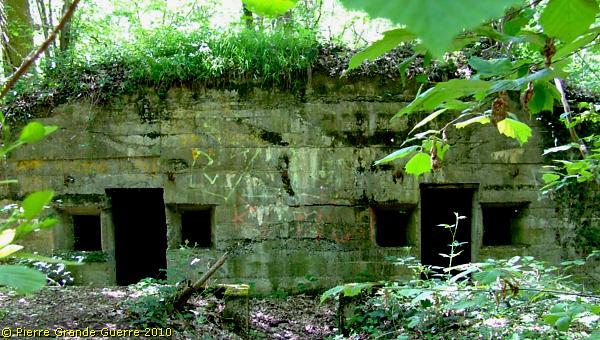
A tour westward departing from Illiès-la Bouchaine to Neuve Chapelle, its Portuguese Military Cemetery and the Indian Memorial at Port Arthur/la Bombe and its German bunkers in the Bois du Biez. Next we visit Chocolat Menier Corner, Richebourg, le Touret Cemetery, the Portuguese Memorial at la Couture, and the Vieille Chapelle Cemetery to finish at the Zelobes Indian Cemetery at the hamlet of l'Embranchement.
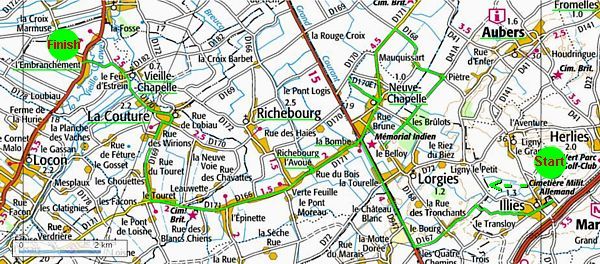
Introduction
These battlefields in this relatively small area around Neuve Chapelle and Richebourg knew many battles: 28 October 1914, 16 December 1914, the spring offensives of 1915, the Battle of Neuve Chapelle (10-13 March 1915), the Battle of Aubers Ridge (9 May 1915), the Battle of Festubert (15-25 May 1915), the Battle of Fromelles (19-20 July 1916) and the German spring offensive of 21 March 1918. For this reason we will find on our route through this area relics and memorials of all war periods. We depart from Illies, a village 4 km. south of Aubers at the German side of the frontline of 1916. Later on this page we will pass and visit other sites relating to all these periods, but we try to concentrate on the Battle of Neuve Chapelle of 1915.
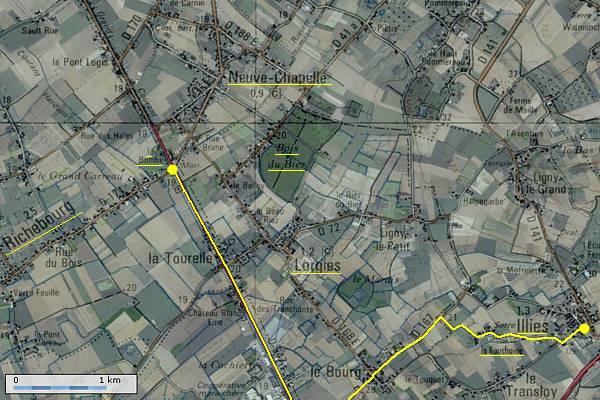
We continue by car north-east in the direction of Neuve-Chapelle to the crossroads of the Rue du Bois and the road of la Bassée-Estaires, in wartimes known as Port Arthur, nowadays called la Bombe.
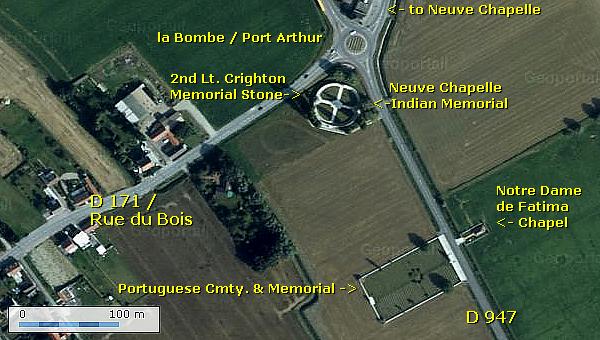
Hundred meters south of la Bombe/ Port Arthur, in the municipality of Richebourg, we first pay a visit to the Portuguese Military Cemetery
.
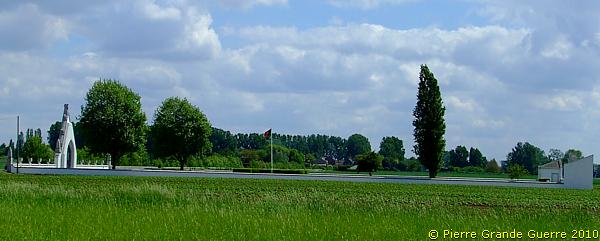
Cemiterio Militar Português
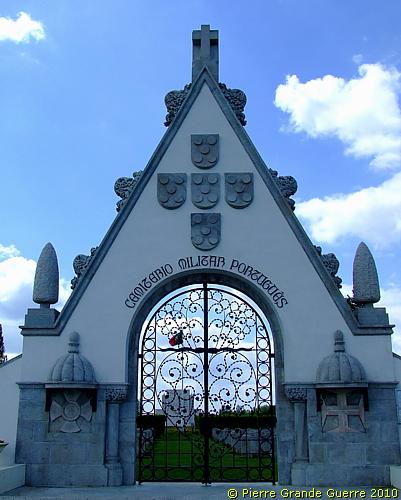
The Cemiterio Militar Português contains 1.831 burials, of whom 239 soldiers are unknown. The graves of these unidentified soldiers are engraved with the text: “Desconhecido” .
The cemetery has been constructed in 1924. Until 1938 the human remains of other Portuguese soldiers, buried first somewhere else in this region like at le Touret, were reburied in this cemetery.

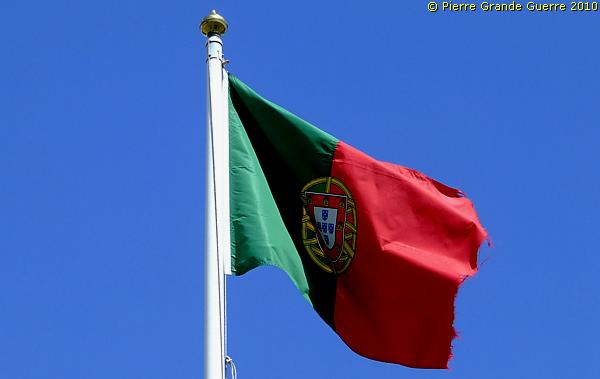
Portugal during the Great War
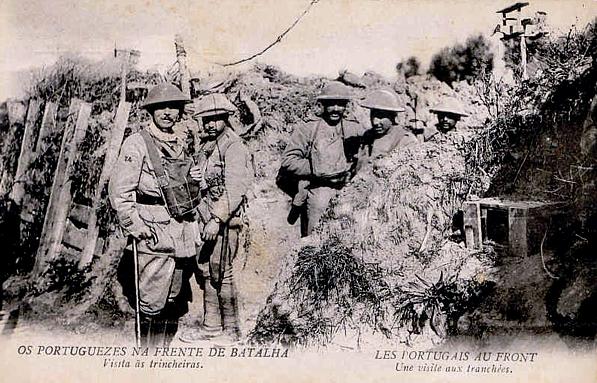
Despite its old alliance with Britain, Portugal kept its neutrality during the first years of war. Portugal suffered from the German U-Boat warfare which sought to blockade the United Kingdom, at the time the most important market for Portuguese products. Clashes also occurred with German troops in the south of the Portuguese colony of Angola, Africa. Initially the Portuguese governments formally stuck to neutrality. Eventually the tension between wanting to comply with British requests and staying neutral grew too great. When Portugal complied with the British request to confiscate the German ships, which were interned in Portuguese ports, Germany reacted on 9 March 1916 by declaring war on Portugal.
The Corpo Expedicionário Português
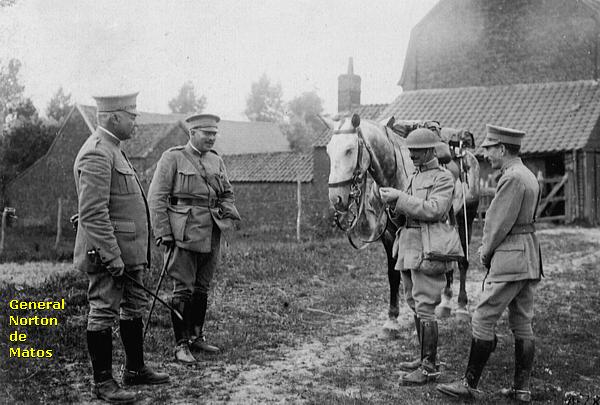
Portugal sent the Corpo Expedicionário Português, (CEP), the Portuguese Expeditionary Corps, under command of General José Norton de Matos (1867-1955). The CEP consisted of two reinforced divisions of in total 40.000 men, which arrived in February 1917 in France.
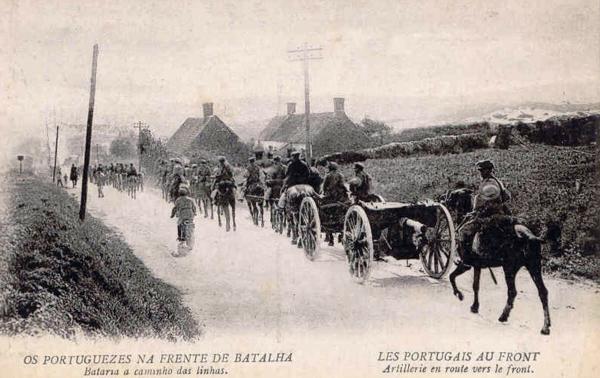
The German spring offensives of March and April 1918 hit the Portuguese hard, with one division destroyed during the German Operation Georgette in the Battle of the Lys of 9 April 1918, during which the nearby village of Neuve Chapelle was lost again to the Germans.
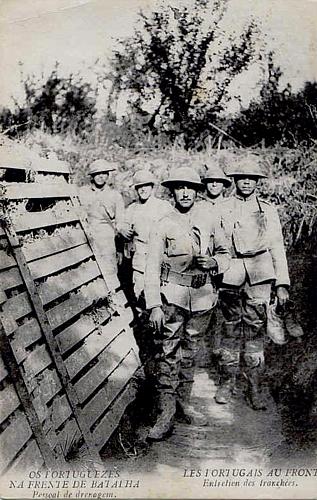
Portuguese Casualties of the Great War
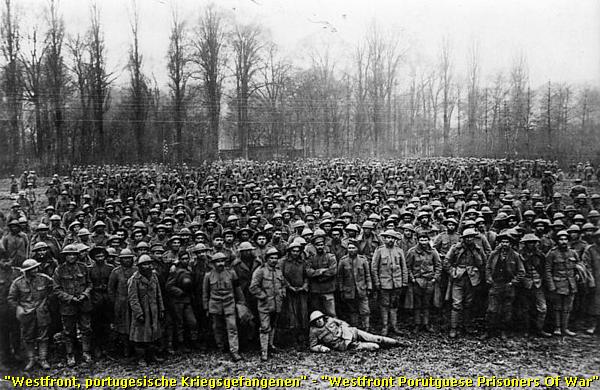
At the end of the war Portugal counted 8.145 fallen soldiers,
13.751 wounded, and 12.318 soldiers missing in action or being made
prisoners of war.
We continue our visit to the cemetery.
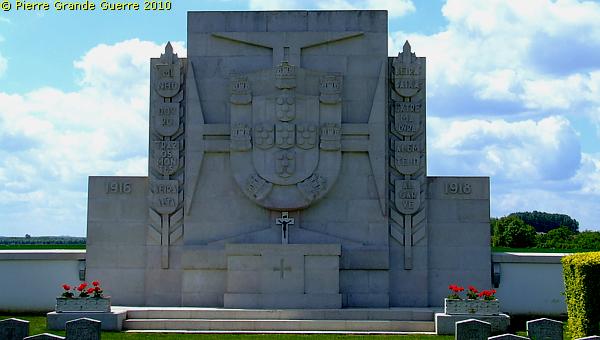
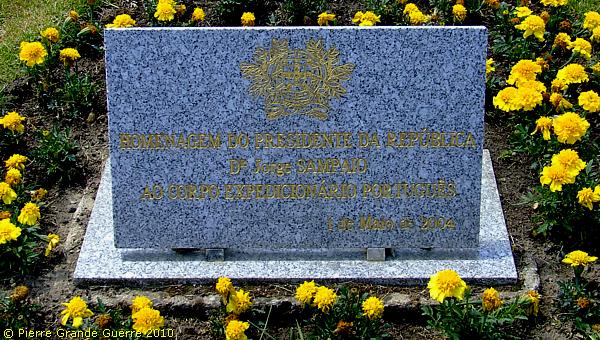
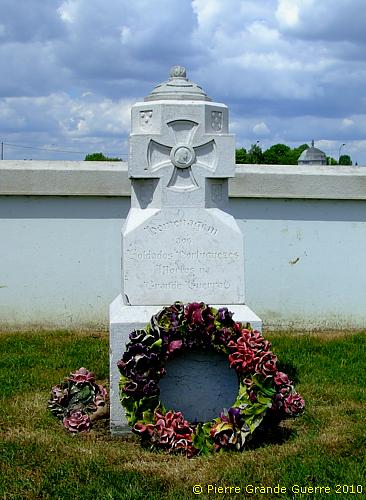

We leave the cemetery and walk about 100 m. northward.

Before we visit the British Indian Memorial, I will spend some words about the historic backgrounds of this location during the Battle of Neuve Chapelle.
The Battle of Neuve Chapelle - 10-13 March 1915
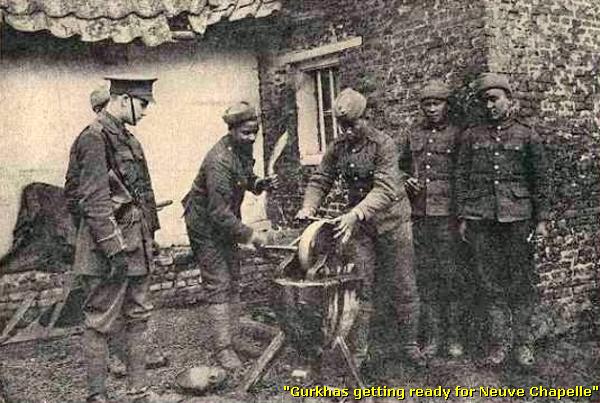
The British, ultimate aim of the Battle of Neuve Chapelle was to cause a rupture in the German lines for a rush on Aubers Ridge to occupy next Lille. On the same time there was planned a French attack of the French 10th Army at Lens, Vimy Ridge, and Arras. The situation in the Champagne sector however, where General d'Esperey's offensive was becoming successful, led to the postponement of this French operation in the Artois.
The Battlefield
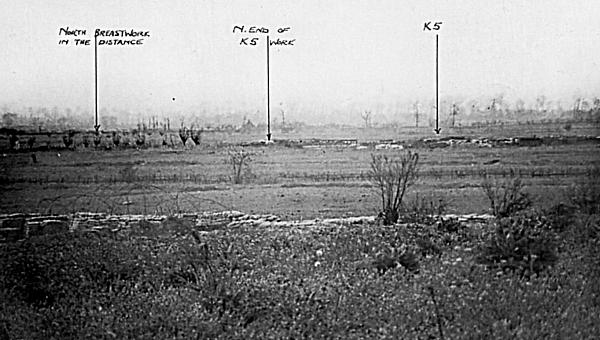
The battlefield around Neuve Chapelle is open, flat country. The ground here is cut by many small drainage ditches. Sometimes in winter the fields were flooded. Because of the high groundwater level of only 60 cm. deep the soldiers were not able to dig trenches in this area, but constructed instead above ground breastworks.
The German Defenders
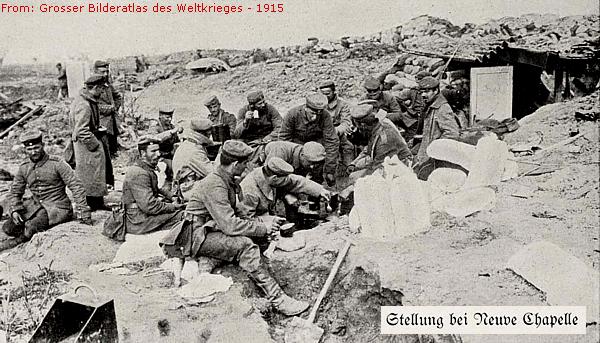
The 13. and 14. Infanterie Divisions belonged together with the 6. Bavarian Reserve Division to the VII. Armeekorps under command of General der Infanterie, Eberhard von Claer. The VII. Armeekorps was a component of General Crown Prince Rupprecht von Bayern’s 6th Army.

The 13. Infanterie Division (13. I.D.), under command of Generalleutnant Kurt von dem Borne, consisted of the 25. Brigade with Infanterie Regiment 13 and I.R. 158 and the 26. Brigade with I.R. 15 and I.R. 55. It was assisted by FeldArtillerie Regiment 22, F.A.R. 58, and several Pioniere units.
The German 14. Infanterie Division, under command of Generalmajor von Ditfurth, consisted of the 27. Brigade with I.R. 16 and I.R. 53, and of the 79. Brigade with I.R. 56 and I.R. 57. It was assisted by F.A.R. 7, F.A.R. 43, and Feld Pioniere Kompagnie 7.
On 10 March 1915 I.R. 13 defended with 2 companies of Jäger Bataillon 11 the first line in and around the village of Neuve Chapelle.
The British Attackers

General Haig deployed units of 2 Army corpses of his 1st Army: Brigades of the (British) Indian Corps under command of General Willcocks, and of the IV Army Corps under command of General Rawlinson. The IV Army Corps consisted of the 7th and 8th Divisions. The Indian Corps consisted of the Lahore Division and the Meerut Division.
Battle Preparations
Aerial Reconnaissance
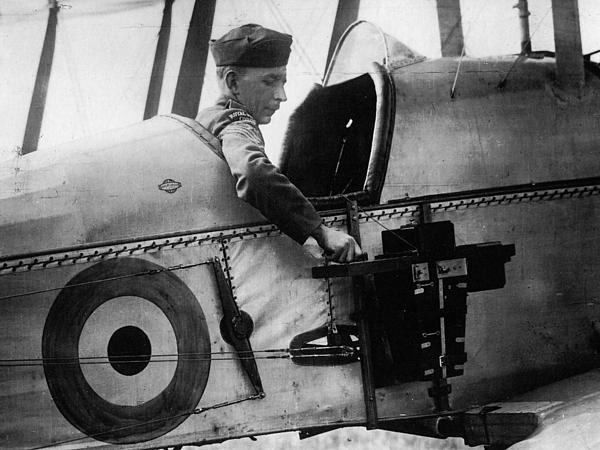
During the preparation of the Battle of Neuve Chapelle it was the first time that aerial photography was to play a prominent part in a major battle. Before the battle the 2nd and 3rd Squadrons of the Royal Flying Corps made for the first time aerial photographs of the German positions. The entire German lines were mapped from the air. These photographs were used for editing the first, rather reliable trench maps of the German lines. Though the aerial photography had been useful to an extent, it was unable to efficiently identify the more strong defensive postitions. During the battle itself the Royal Flying Corps quickly secured aerial dominance, and it set about bombarding German reserves and transports to defend the threatened lines.
Preliminary Bombardment
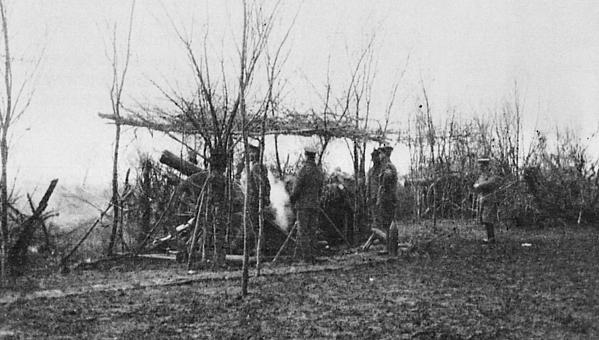
Due to a serious lack of shells the preliminary bombardment started at 7.30 AM with 342 artillery guns, but lasted only in total 65 minutes. The first phase of a 35 minute bombardment was directed at the front line, then the next phase of 30 minutes was aimed at the village and second line positions behind the village, like the Smith Dorrien Trench.
The Ground Offensive
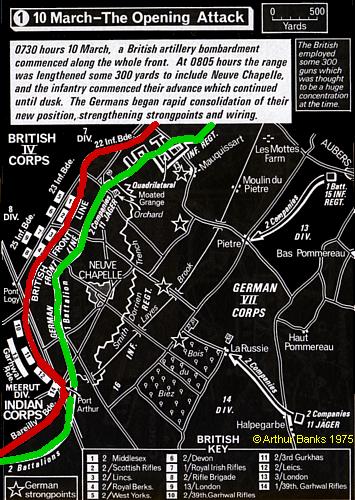
Despite the poor weather conditions, the early stages of the battle went extremely well for the British. Major-General Davies commanded the 23rd and 25th Brigades and attacked at the left flank, at the centre and north of the village.
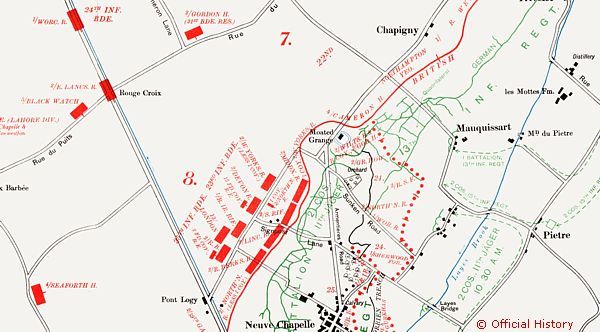
The 25th and 23rd Brigades of the 8th Division made good progress against the village. In the centre of the attack, two companies of the German Jäger Battalion 11 (with approx. 200 men and a single machine-gun, surviving the initial shelling) delayed the advance for more than six hours, until these companies were forced to retreat. At nightfall the village had been captured, and the advanced units had reached positions as far forward as the Layes brook. With the British there were also a lot of communication problems, like delays in sending further orders and reinforcements forward.
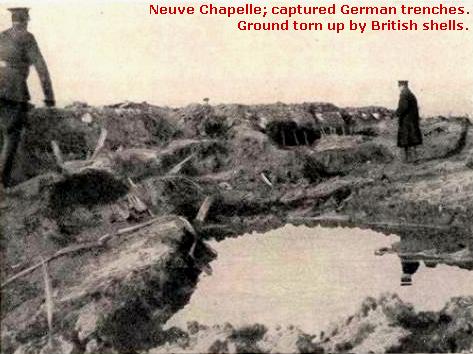
Lieutenant General Jacob commanded the Dehra Dun Brigade of the Indian Meerut Division and attacked at the centre and south-west of Neuve Chapelle.
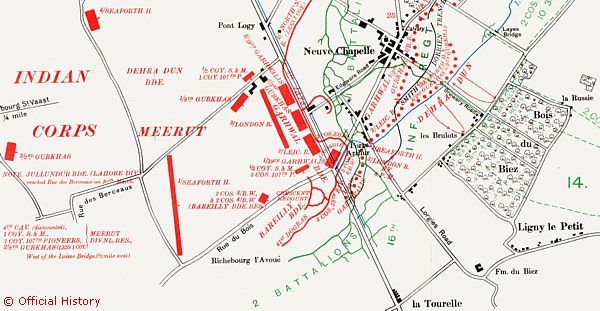
Lieutenant-General Anderson led the Garhwal Brigade at the right flank, which attacked from Port Arthur to the Layes brook and the Bois du Biez (Wood of Biez).
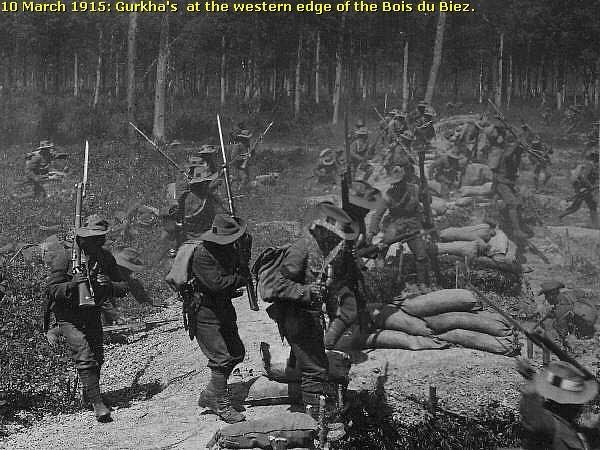
These tree infantry brigades were ordered to advance quickly, as soon as the barrage lifted from the front line at 8.05 AM.
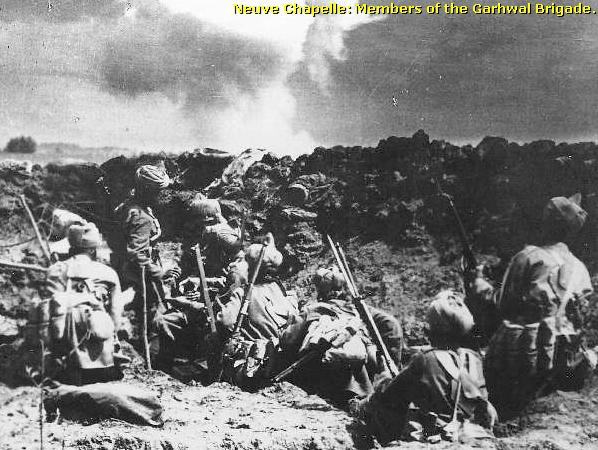
The Gharwal Brigade of the Indian Corps advanced successfully, with the exception of the 1/39th Gharwal Rifles on the extreme right. The 1/39th went astray and plunged into a barbed wire defence, untouched by the bombardment. The 1/39th Gharwal Rifles suffered many losses.
German Reinforcements at the second line
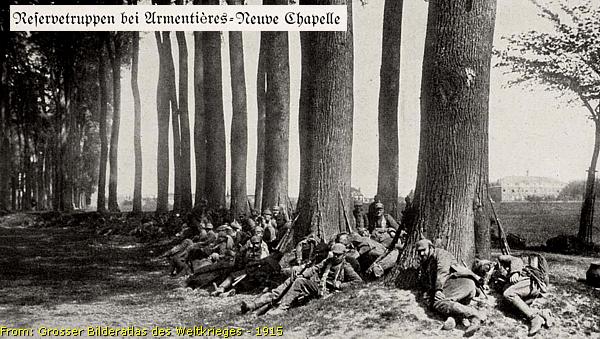
During the night the Germans reinforced their second line in front of the Bois du Biez. Crown Prince Rupprecht von Bayern ordered Generalmajor von Ditfurth to organise reserve troops to deploy counterattacks. These reserves arrived at 12 March.
All further British attempts over the next few days brought little material success.
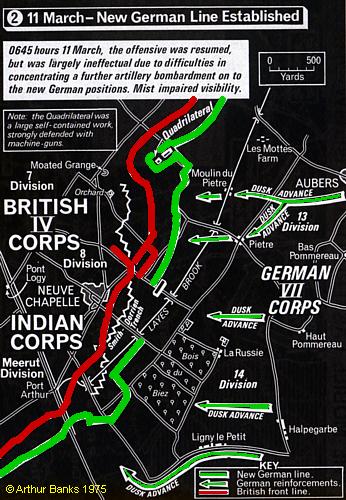
12 March: German Counterattacks
On 12 March under command of Generalmajor von Ditfurth the 14. Division, reinforced with the Bavarian 14. Reserve Infanterie Brigade, launched a series of counterattacks, which managed at least to halt the British advancement any further .
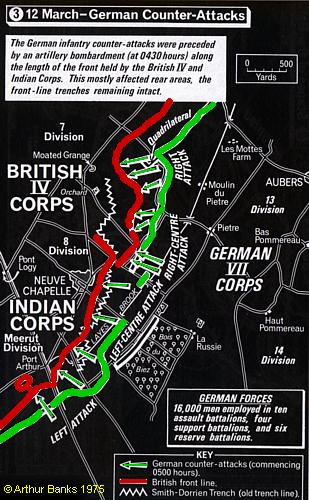
The campaigns of both sides were officially abandoned on 13 March. Both parties settled down to consolidate their positions, they still held.
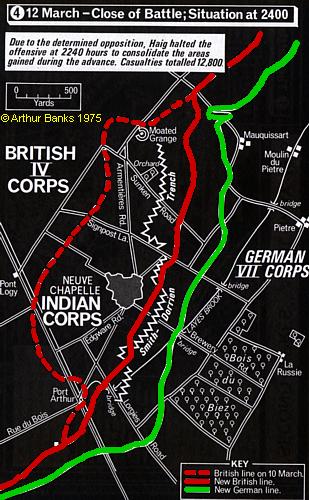
Casualties
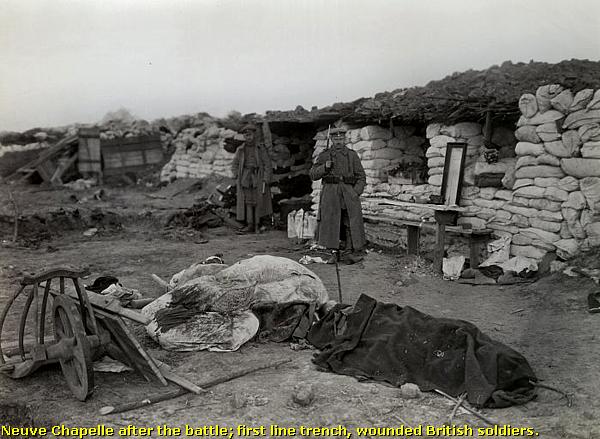
40.000 British troops took part during the battle and suffered all together 11.200 casualties; 7.000 British and 4.200 Indians.
The Germans lost around the same number. During the period of 6 – 29 March 1915 the 13 I.R. for instance suffered 21 officers and 1.301 NCO’s as casualties, killed, wounded, or missing. During the period of 7- 12 March 1915 the 8th Battalion of the 16. I.R. of the 14. I.D. counted 589 casualties, among these 16 officers.
After all the British succeeded in capturing only some 2 km. of lost ground.
The Aftermath: Shell Crisis
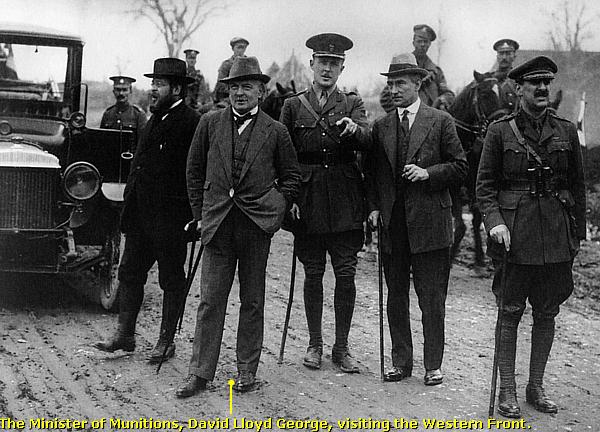
After the failure of the Battle of Neuve Chapelle, the British Commander-in-Chief, Field Marshal Sir John French, claimed that it failed due to a lack of shells. This led to the Shell Crisis or Shell Scandal of 1915, which brought down the Liberal British government under the Premiership of Lord Asquith. He formed a new coalition government, dominated by Liberals, and he appointed David Lloyd George as Minister of Munitions . It was Lloyd George, who changed and geared the whole economy into a war economy, focusing at the change to mass production of war materials like shells.
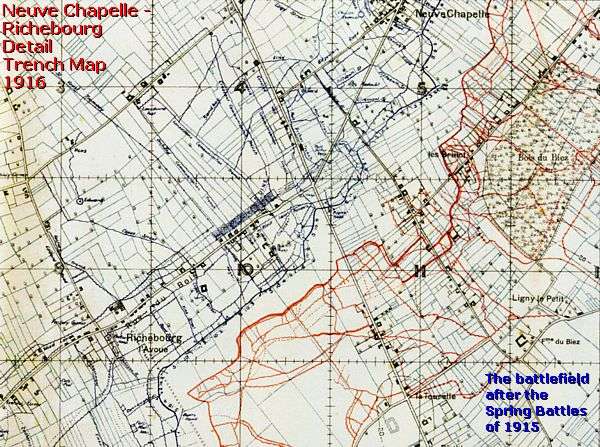
After this intermezzo we have arrived at the northern part of the circular wall around the Neuve Chapelle Indian Memorial .
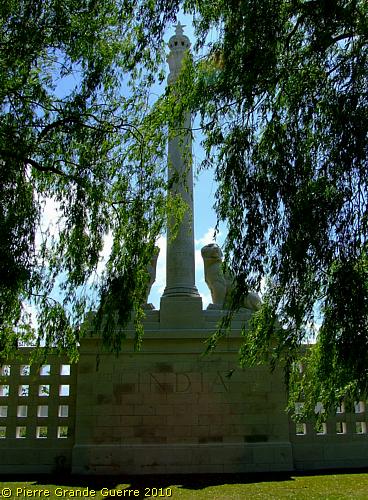
The Neuve Chapelle Indian Memorial
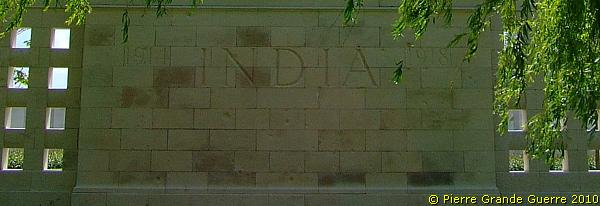
The Neuve Chapelle Indian Memorial commemorates 4.742 Indian soldiers with no known grave, who fell in battle while fighting for the British Indian Corps during the Great War. The location of the memorial was chosen because of the participation by Indian troops at the Battle of Neuve Chapelle.
The memorial, designed by Sir Herbert Baker with lion sculptures by Charles Wheeler, is a circular enclosure. One half of the circular enclosure consists of panels of names of the dead, while the other half is open. Other architectural and sculptural features of the memorial include two small domed chattris. The main inscription is in both English and French, while the column also bears an inscription in English, Arabic, Hindi and Gurmukhi: "God is One, His is the Victory".
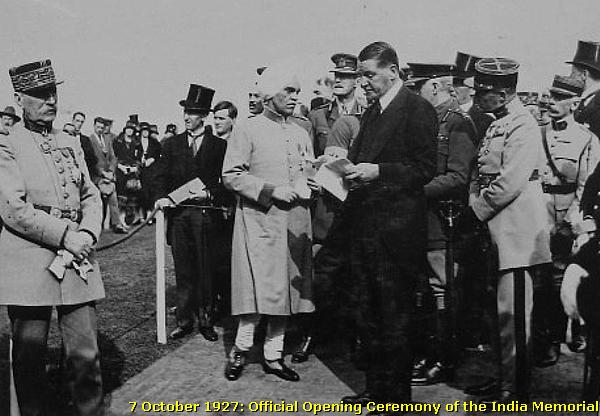
| The memorial was unveiled by the Earl of Birkenhead on 7 October 1927. The Earl of Birkenhead (Frederick Edwin Smith), who was present as Secretary of State for India, had served in France from 1914 to 1915 as a staff officer with the Indian Corps. Also present at the ceremony were Field Marshall Jacob, in the beginning of 1915 still Major-General and commander of the Dehra Dun Brigade and from September 1915 commander of the Meerut Division, next the French Minister of Colonies, Perrier, and Marshal Ferdinand Foch, who speeched in French. Attending the ceremony was a contingent of troops from India to represent the units that fought in France, including Sikhs, Dogras, and Garhwalis. There are two recipients of the Victoria Cross commemorated on the Neuve Chapelle - Richebourg Memorial: William Arthur McCrae Bruce, and Gobar Sing Negi. |
The central pillar bears an inscription in English, Arabic, Hindi and Gurmukhi:
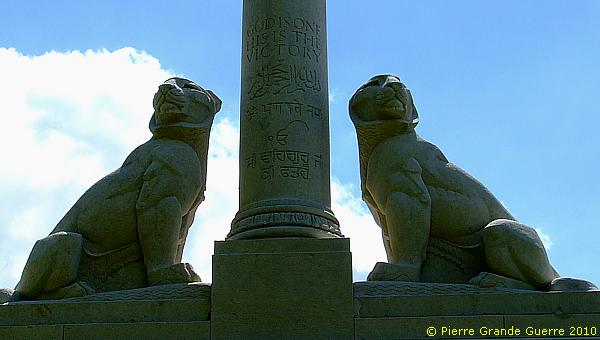
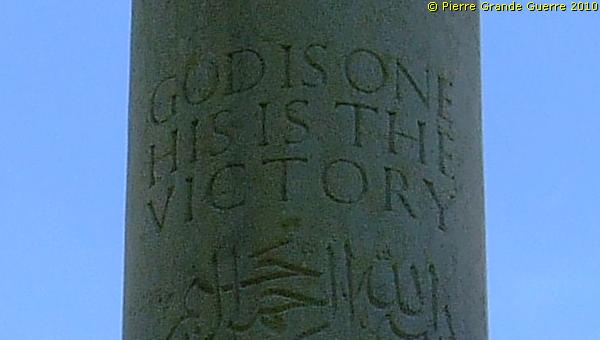
We enter the India Memorial via the eastern chattri.
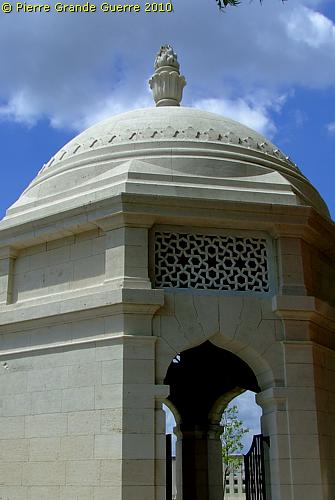
View from the eastern chattri to the western chattri.
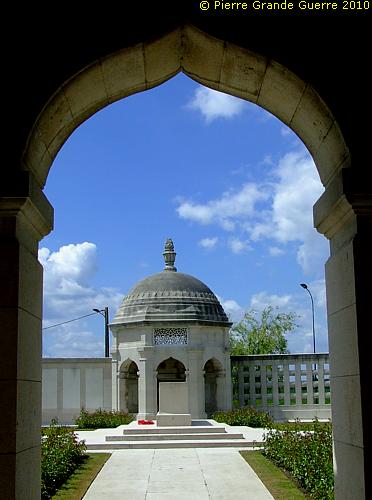

The central pillar, topped by a lotus capital, and carved representations of the Star of India and the Imperial Crown.
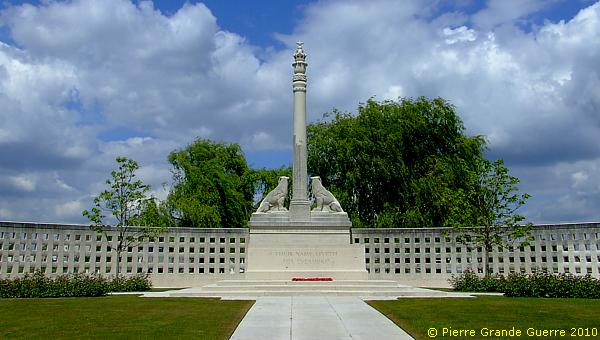
The wall beneath the lions mentions all battlefields, where British Indian soldiers fought.
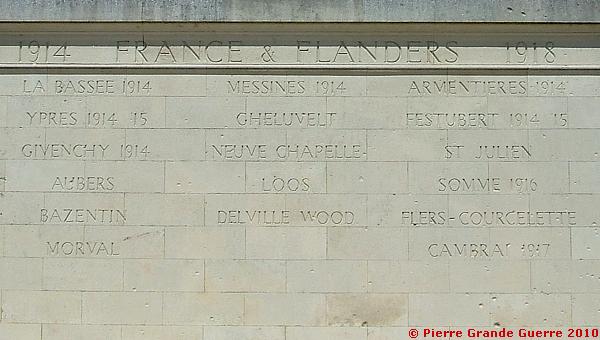
The Indian Corps

From the early days of the war the Indian Corps saw a significant amount of combat around Neuve Chapelle. First the Indian Corps attempted to seal the breach, that the Germans (under General Erich van Falkenhayn) had created in the British Line just south of Neuve-Chapelle. On 28 October 1914 the Indian Corps initially succeeded in entering into the village of Neuve Chapelle, but were forced to retreat after a strong German counter attack. Further fighting continued for a week with the additional loss more than 500 Indians killed, with 1.450 wounded. In December 1914 the Indian Corps moved to the Givenchy area south of Neuve Chapelle. On 16 December 1914 they attempted to capture a German front trench line without success, losing 54 men. This raised the total number of killed men to that date to over 2.000.
The Indian Corps provided half the attacking force at the Battle of Neuve Chapelle. It was one of the major engagements for the Indian Army on the Western Front. Elements of the Indian Corps participated in attempts to break the German lines at Neuve Chapelle and went on to capture Aubers.
During the Battle of Neuve Chapelle some logistical failures in moving British guns within range to cover the advance caused that Indian troops had to attack without covering fire. By these artillery failures almost 1.000 Indian soldiers were killed.

In front of the Memorial Wall: the Stone of Remembrance.
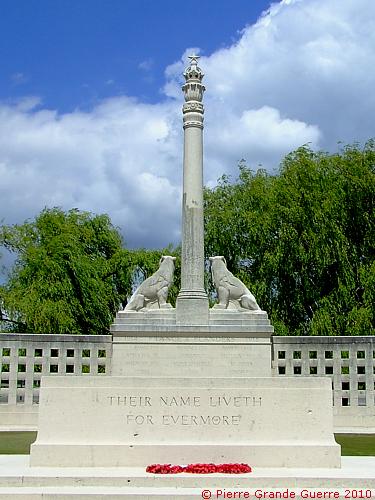
The west chattri.
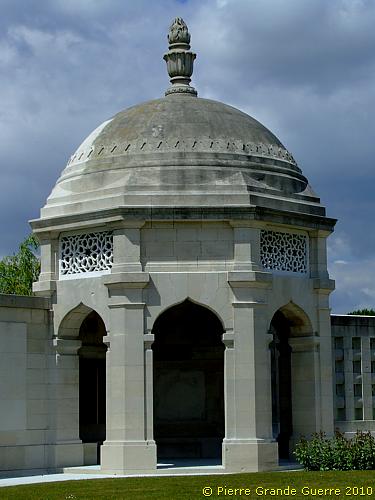
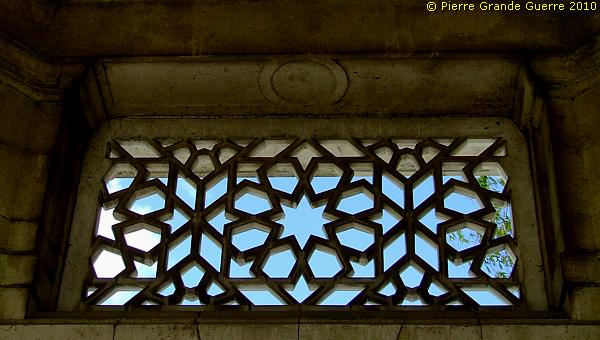
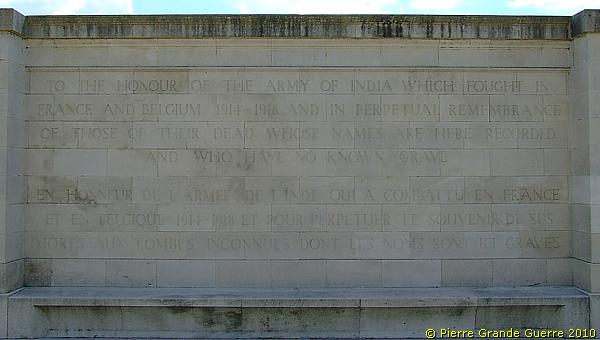
One half of the enclosure consists of panels with endless lists of names of the dead.
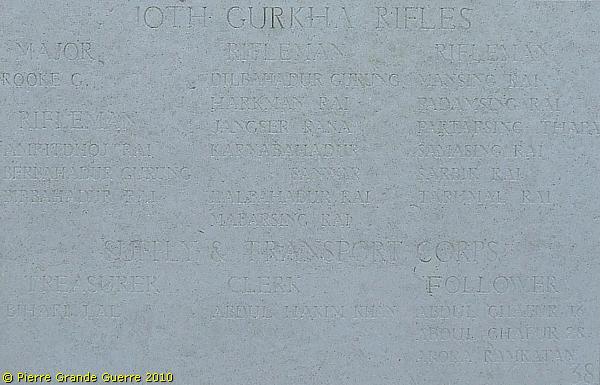
On the panels you will encounter different British Indian Army ranks, like Lance Naik and Sepoy.
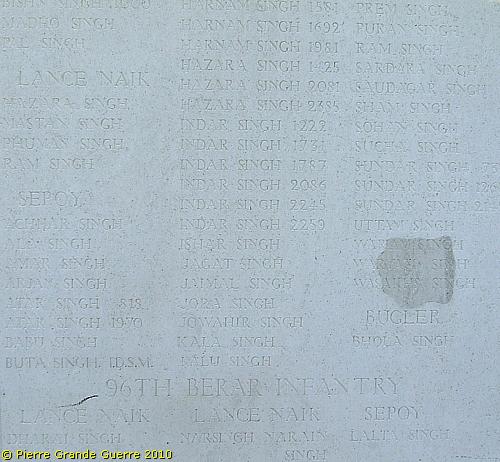
The British Indian Army rank system
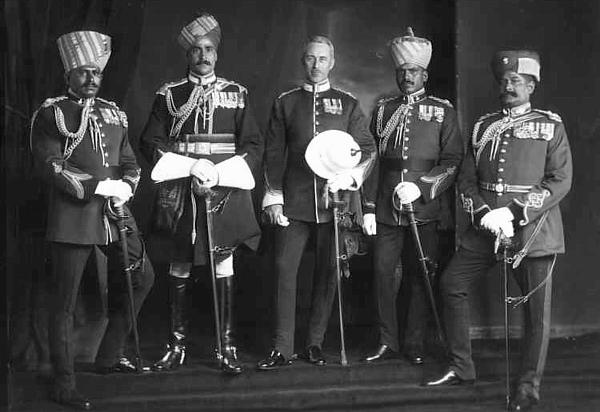
Commissioned Officers
Commissioned officers, British and Indian, held identical ranks to commissioned officers of the British Army.
Viceroy's Commissioned Officers
Viceroy's Commissioned Officers were Indians holding officer ranks. They were treated in almost all respects as commissioned officers, but only had authority over Indian troops and were subordinate to all British King's (and Queen's) Commissioned Officers and King's Commissioned Indian Officers.
- Subedar Major or Risaldar-Major (Cavalry) equivalent to Major
- Subedar or Risaldar (Cavalry) equivalent to Captain
- Jemadar equivalent to Lieutenant
Non-Commissioned Officers
- Company Havildar Major equivalent to Company Sergeant Major
- Company Quartermaster Havildar equivalent to Company Quartermaster Sergeant
- Havildar or Daffadar (Cavalry) equivalent to Sergeant
- Naik or Lance-Daffadar (Cavalry) equivalent to Corporal
- Lance-Naik or Acting Lance-Daffadar (Cavalry) equivalent to Lance-Corporal
Soldiers
- Sepoy or Sowar (Cavalry) equivalent to Private, or Gunner, or Sapper.
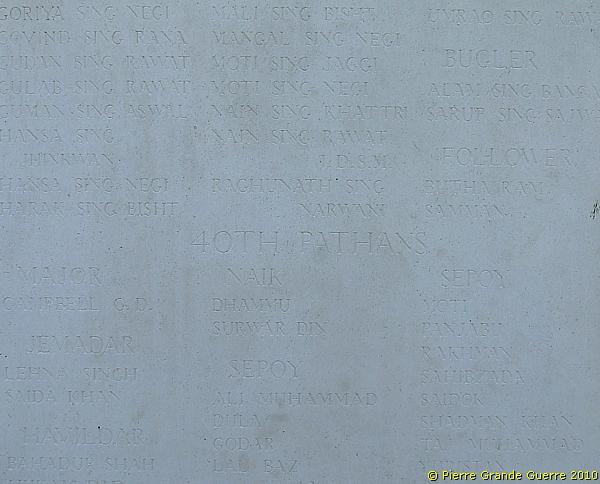
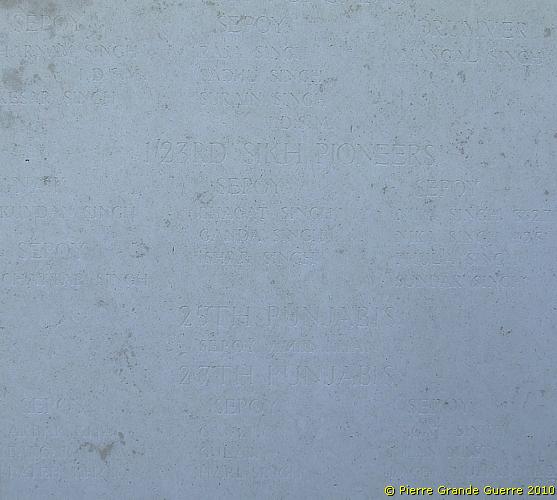
In 1964 a bronze panel was added, which includes the names of 206 soldiers, whose graves were first at Zehrensdorf (Germany).
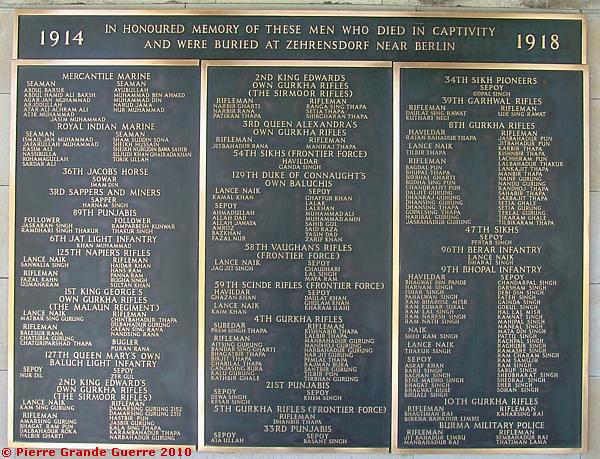
For one reason or another these German graves could not be preserved.
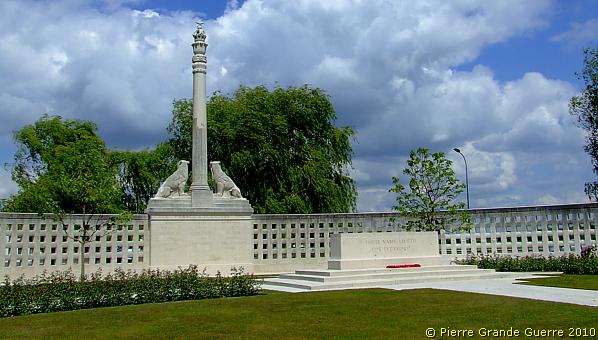
We leave the memorial, and outside we return to the west, to find this private memorial along the infamous Rue de Bois.
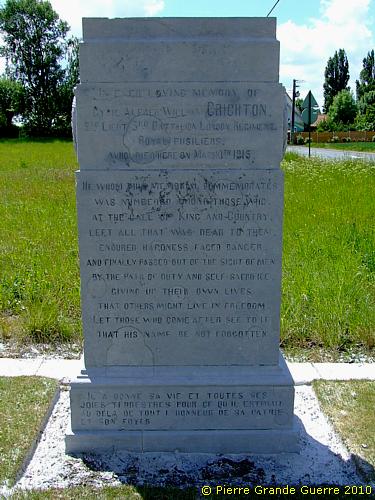
The Memorial of 2nd. Lt. Crighton of the 3rd. Battalion London Regiment Royal Fusiliers, who fell on 10 March 1915 near this spot. (On the other side of the crossroads, the memorial has been moved.)
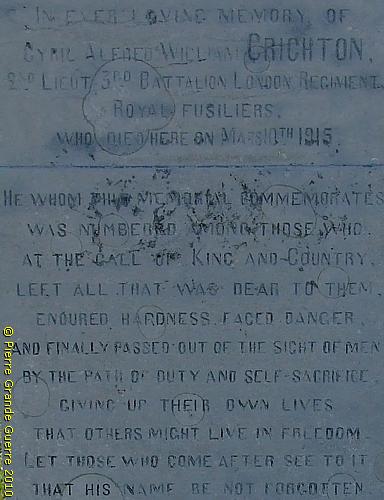
We continue our route by car entering the village of Neuve Chapelle .
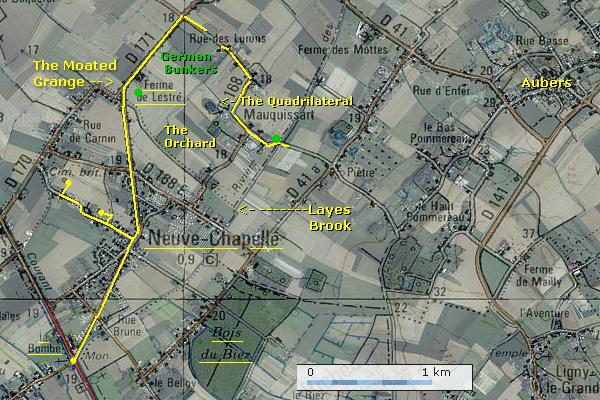
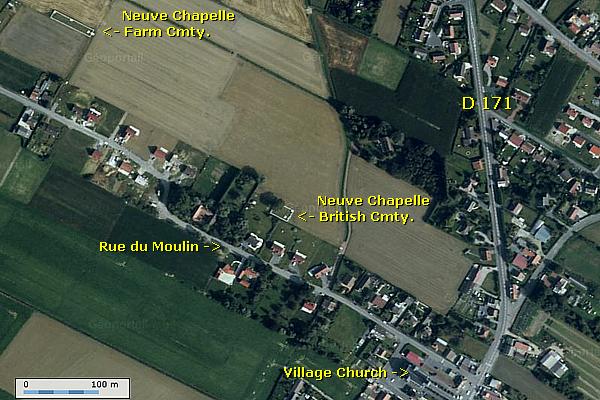
Neuve Chapelle, seen from the south-east. The village has given its name to the battle, which began on 10 March 1915.
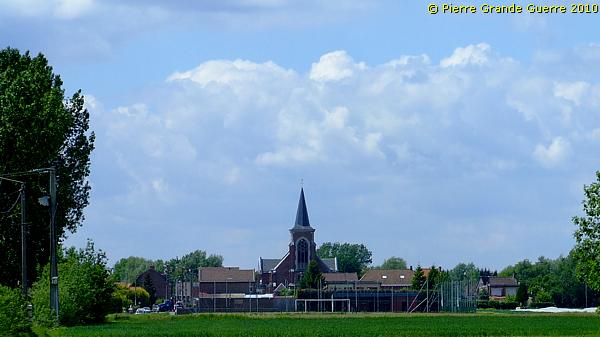
On the western edge of the village lie two British cemeteries.
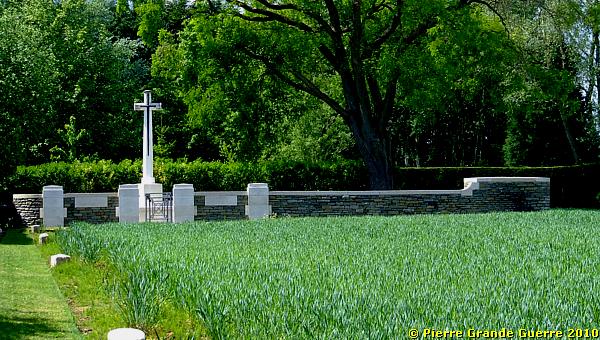
Neuve Chapelle British Cemetery
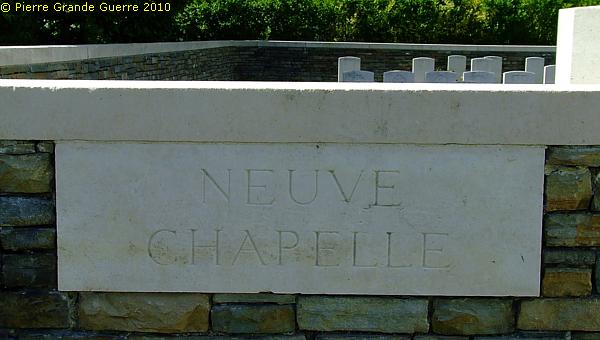
The
Neuve Chapelle British Cemetery
was
begun during the Battle of Neuve Chapelle and used until the following
November. The Cemetery was known at one time as Moggs Hole Cemetery.
There are now over 50, 1914-18 war casualties commemorated in this
site. Of these, a small number are unidentified and special memorials
are erected to six soldiers from the United Kingdom known to be buried
in these graves. The Cemetery covers an area of 452 square metres
and is enclosed by a rubble wall.
Source
of all Commonwealth cemeteries on this web page: Commonwealth War Graves Commission
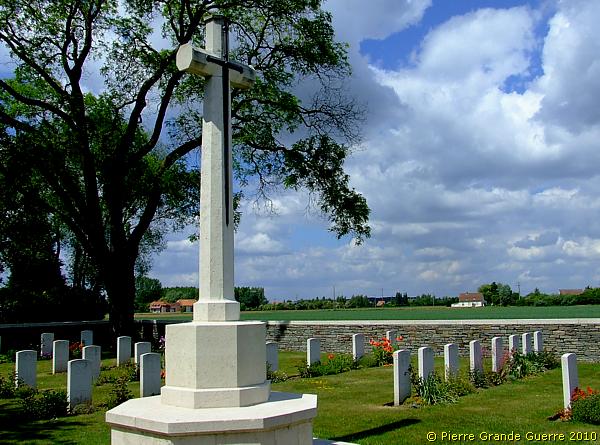
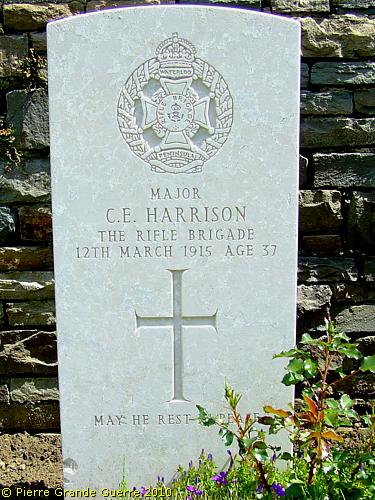
Special memorials record the names of five soldiers, buried in Neuve Chapelle churchyard, ...
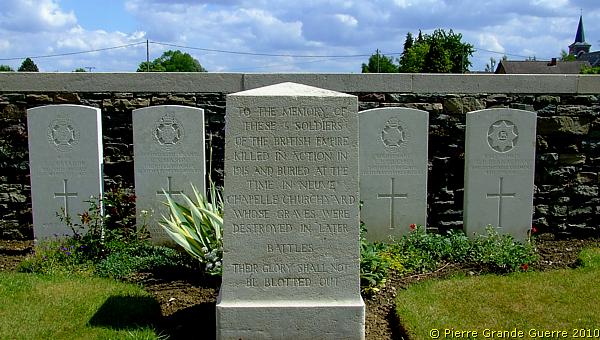
... whose graves were destroyed by shell-fire.
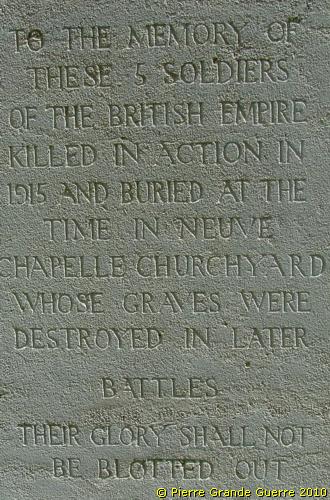
Right at the horizon lies the Neuve Chapelle Farm Cemetery.
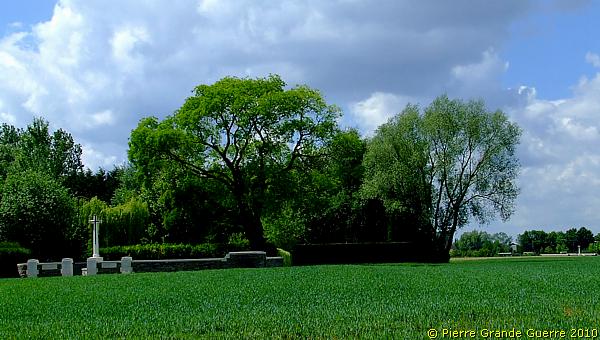
Neuve Chapelle Farm Cemetery
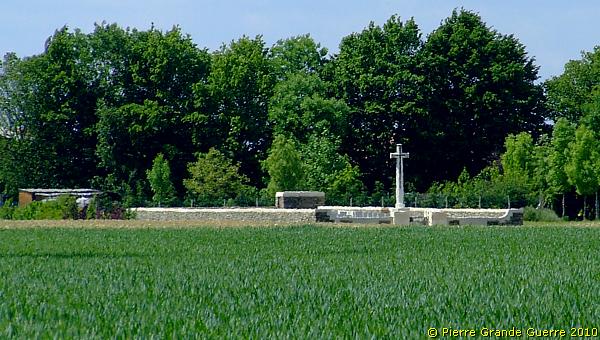
| Neuve Chapelle Farm Cemetery was begun by the 13th London Regiment (The Kensingtons) during the Battle of Neuve Chapelle. There are now over 60, 1914-18 war casualties commemorated in this site. Of these, nearly half are unidentified and special memorials are erected to 13 men of the Kensingtons, who are buried among them. The cemetery covers an area of 585 square metres and is enclosed by a rubble wall. |
Due to heavy traffic we are for safety reasons forced to stay in the car. Alas we have to pass infamous sites like the Orchard, the Moated Grange, the Lestré Farm, and the Quadrilateral without being able to take pictures. But near the hamlet of Mauquissart and the bridge over the Layes brook, we were able to safely park our car to inspect this German bunker.
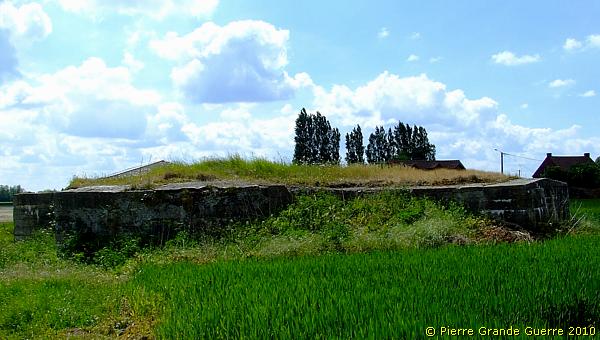
This second line bunker is near the location of the Nameless Cottages, ...
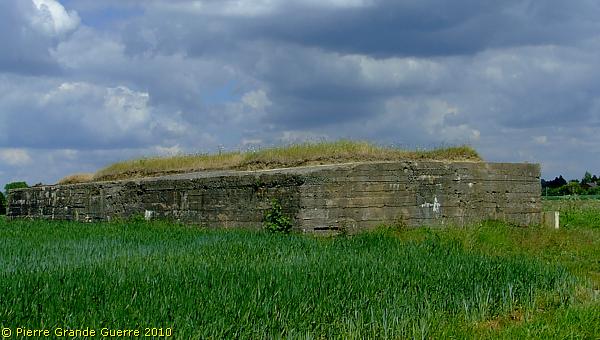
... and stands along the Rue du Pietre. I did not enter it, because it was alas filled with recent garbage.
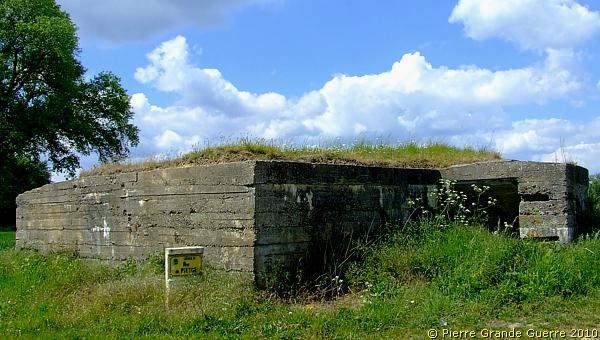
We continue to the Bois du Biez, passing other German bunkers in the fields on the left side and on the right side of the road.
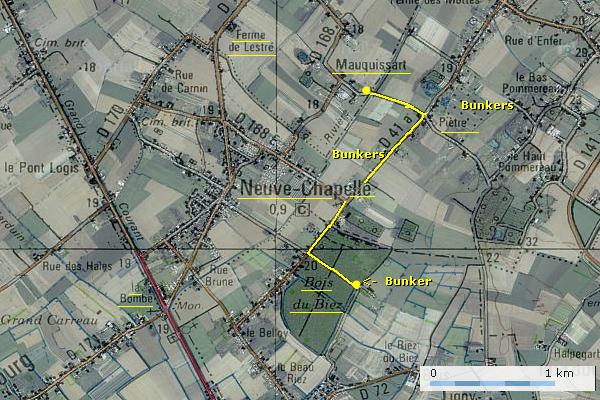
The western edge of the Bois du Biez, until where the Gurkhas came and were forced to retreat.
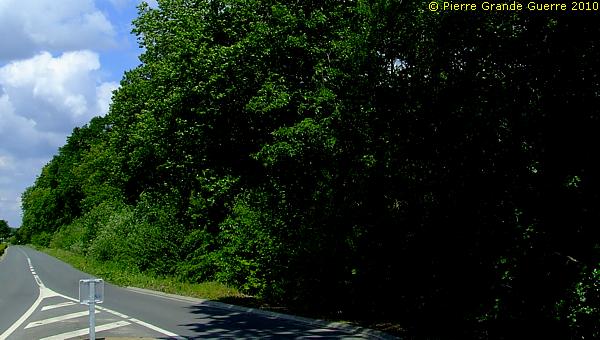

From the junction to the entrance to the Bois du Biez: a view at Neuve Chapelle.

Wood of Biez

In 2010 we made our first visit to the Bois du Biez. In 2014 we continued our explorations into the wood.
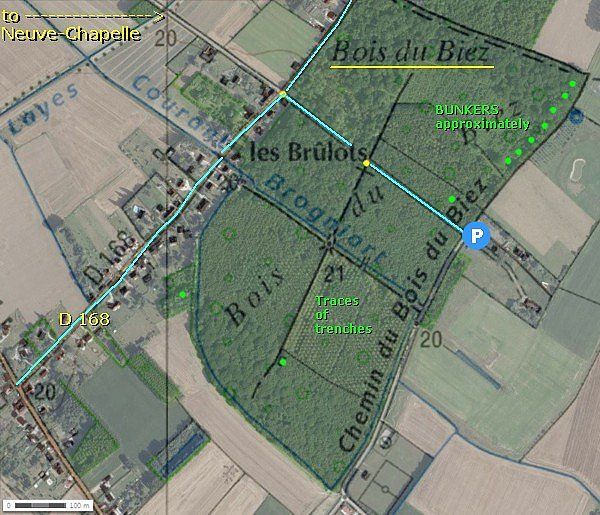
We enter the Bois du Biez from the west.
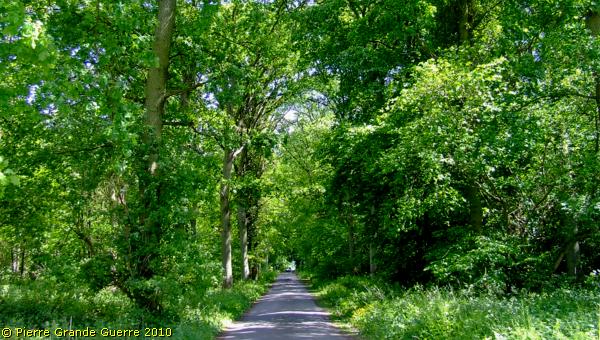
At the eastern edge of the wood I made a short walk to detect this German double dug-out bunker.

The interior of the left bunker.
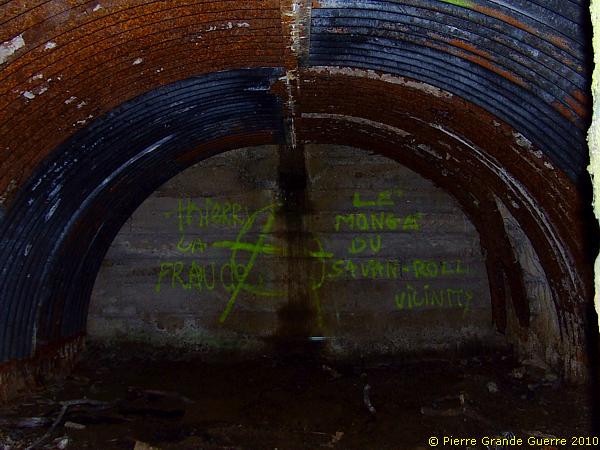
The interior of the right bunker.
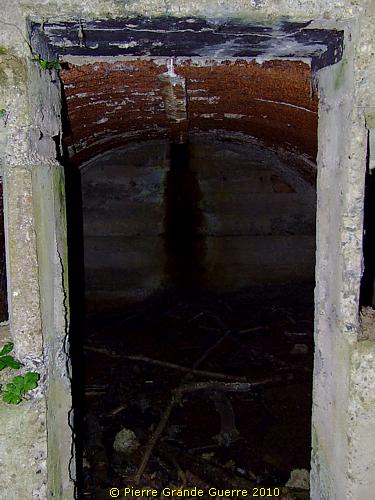
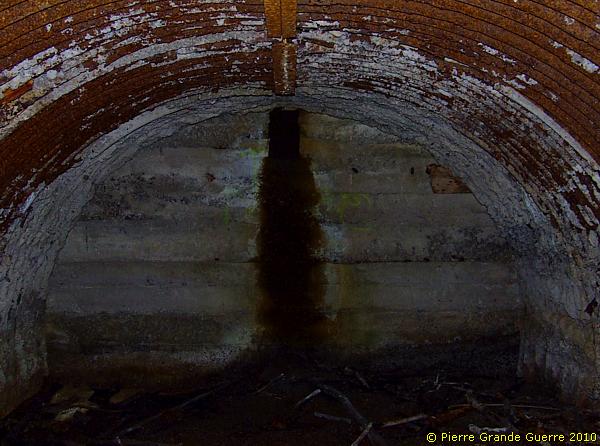
In 2014 we continued to explore the bunkers on the east edge of the Biez Wood.
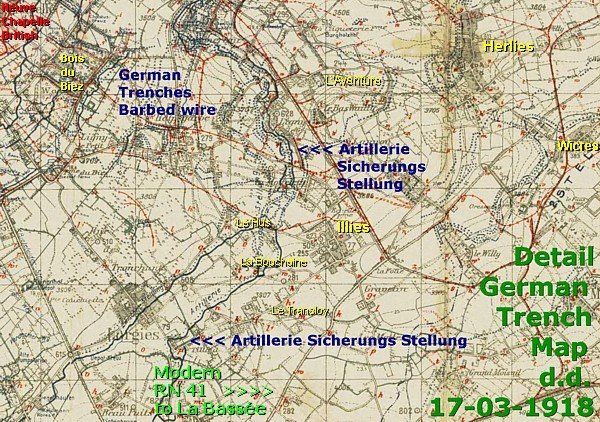
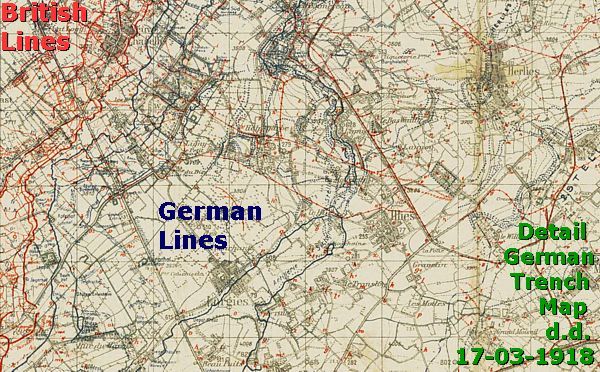
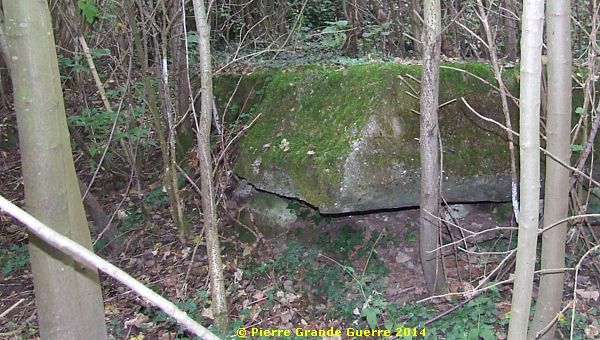
Unfortunately, due to a sloppy back-up I lost my 2014 notes of our visit to the Bois du Biez. But I can still show you my images of the German concrete bunkers hidden under the vegetation.

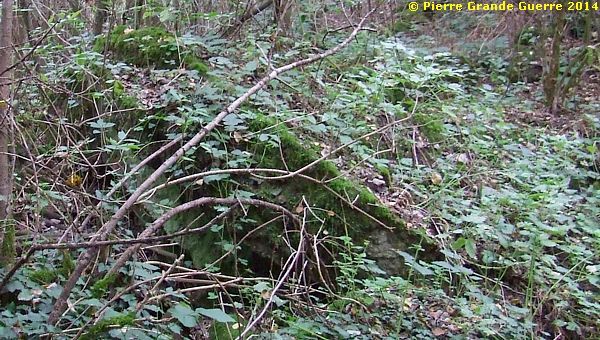
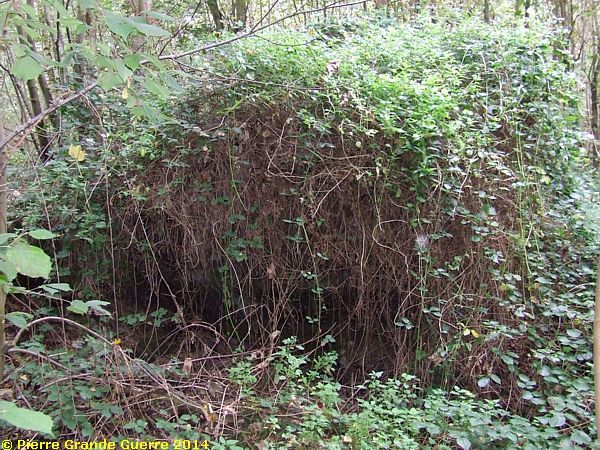
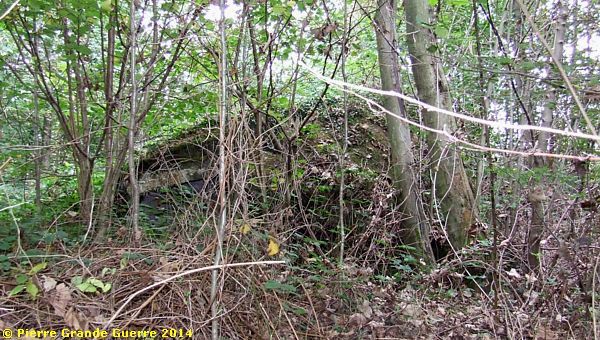

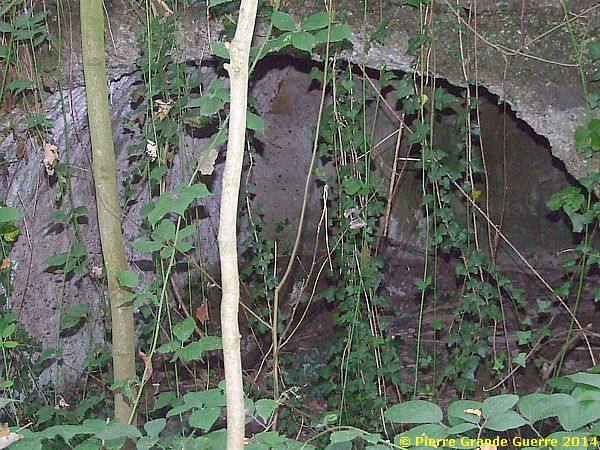
A "Kaserne" bunker.
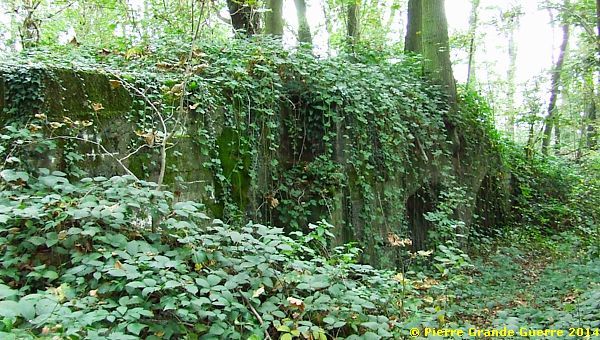
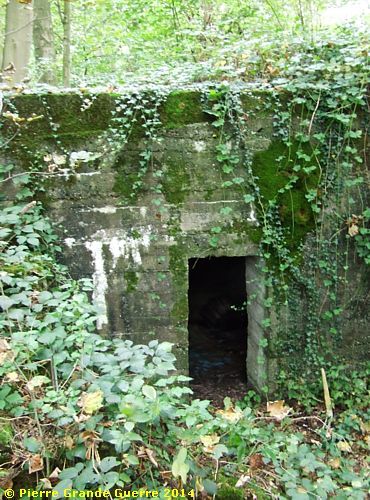
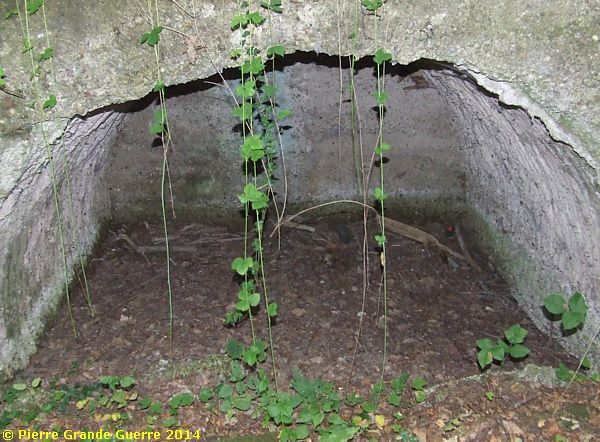
Remains of ammunition bunkers.


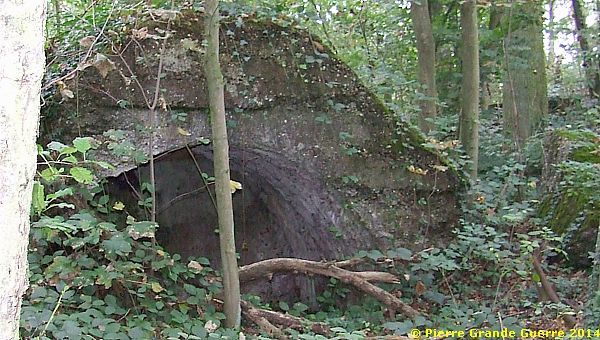

We continue...
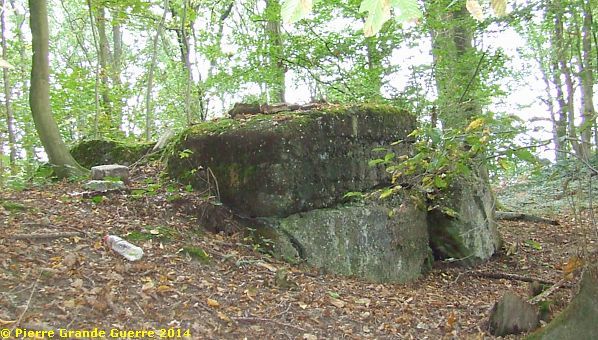
Our last bunker in the Bois du Biez is perhaps the most interesting.
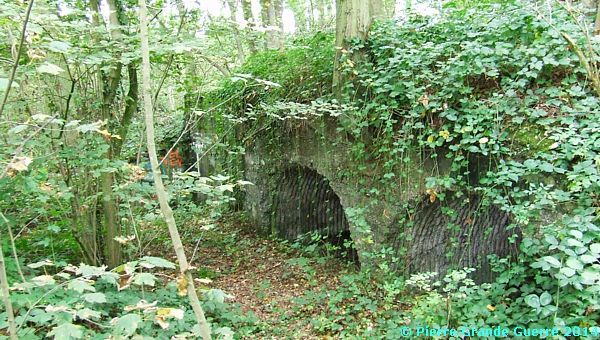

A ventiation shaft sticks out of the top construction.
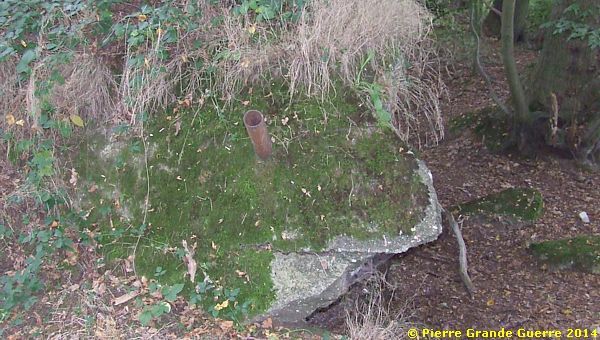
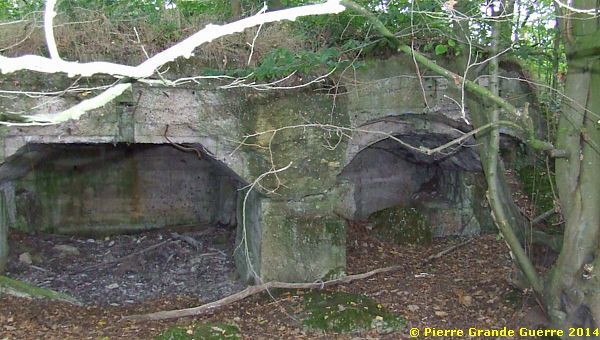
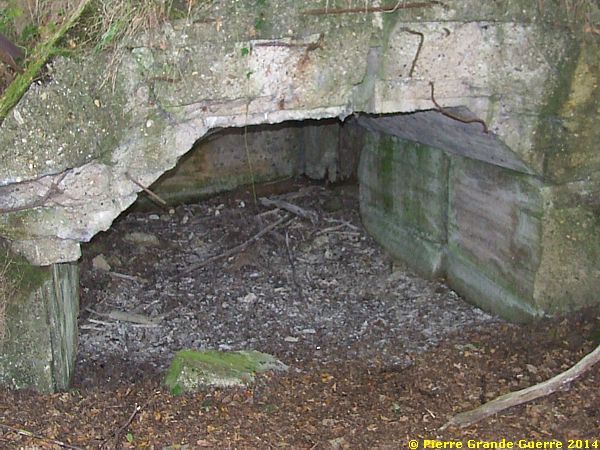
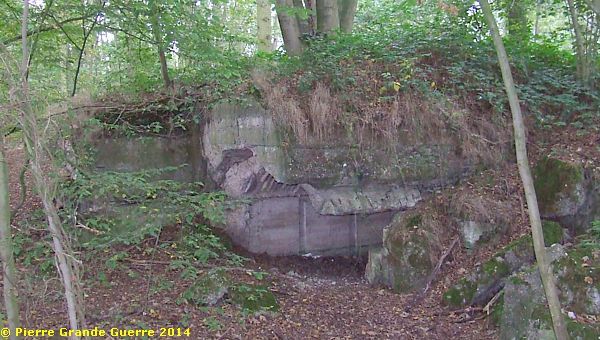
I made this photo to show you the layers of concrete of the top of the bunker.

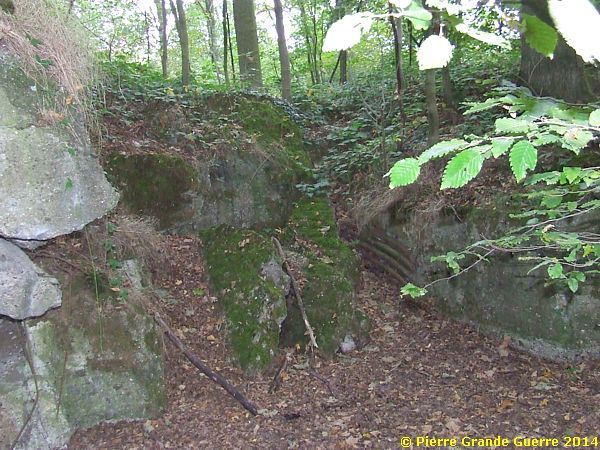
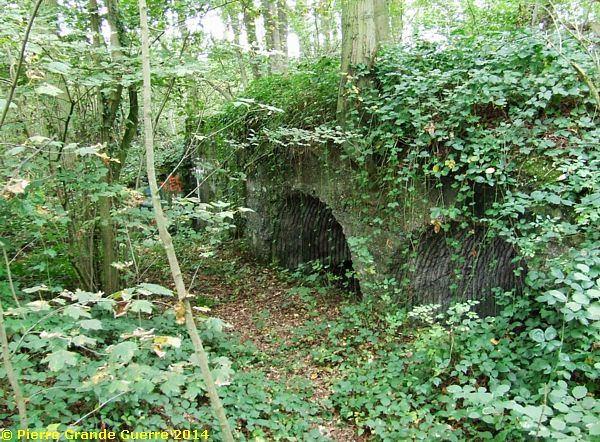
We leave the wood and we return to the crossroads ...
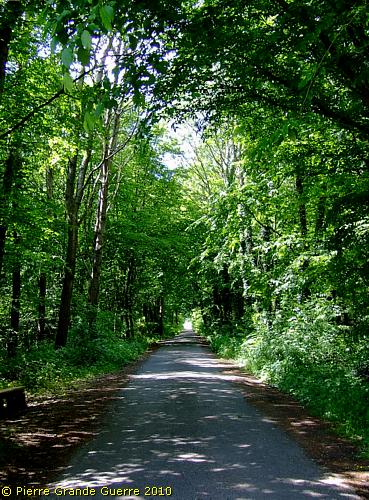
... of Port Arthur / la Bombe, to continue westward, along the Rue du Bois, the D 171, ...
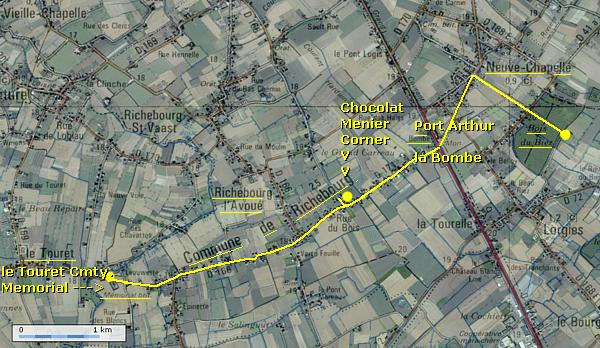
... to Chocolat Menier Corner .
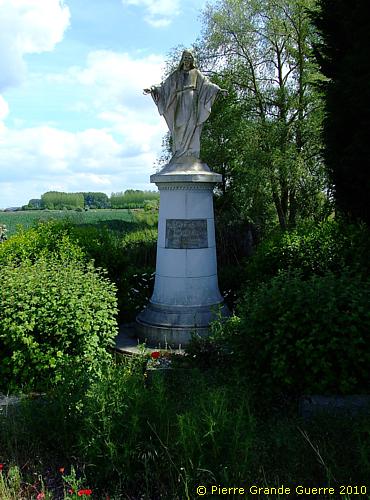

Like in other sectors of the Western Front on that day, as for instance near St. Yvon , Belgium, on 25 December 1914, in these fields around Chocolat Menier Corner, German and Indian soldiers of the 39th Garhwal Rifles rated a Christmas Truce.
The site of the Christmas Truce: the field at Chocolat Menier Corner.
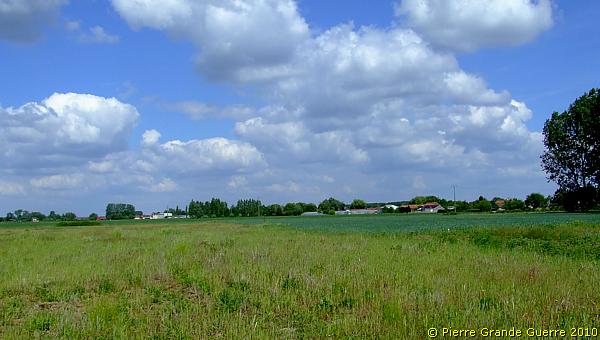
Along the Rue du Bois we continue westward, ...

... for a visit to the le Touret Cemetery & Memorial .

Le Touret Cemetery
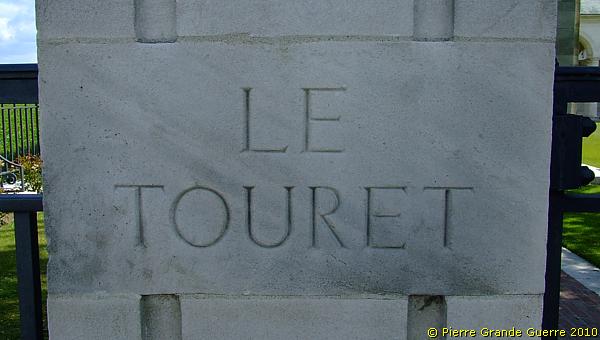
| Le Touret Cemetery was begun by the Indian Corps (and in particular by the 2nd Leicesters) in November 1914, and it was used continuously by Field Ambulances and fighting units until March 1918. It passed into German hands in April 1918, and after its recapture a few further burials were made in Plot IV in September and October. The grave of one Officer of the London Regiment was brought in in 1925 from a position on the Estaires-La Bassee road near "Port Arthur". There are now over 900 1914-18 war casualties commemorated in this site. The graves of three men of the King's Liverpool Regiment, which were destroyed by shell fire, are now represented by special headstones. The Cemetery covers an area of 7.036 square metres and is enclosed by a low brick wall. Located at the east end of the cemetery is Le Touret Memorial, which commemorates over 13.000 servicemen, who fell in this area before 25 September 1915 and who have no known grave. |
With a quick glance over the cemetery, ...
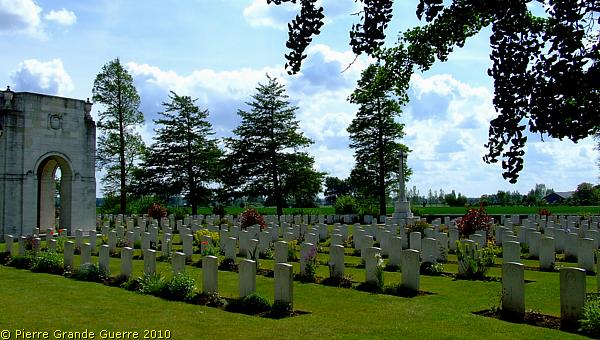
... I prefer to visit first the impressive le Touret Memorial .
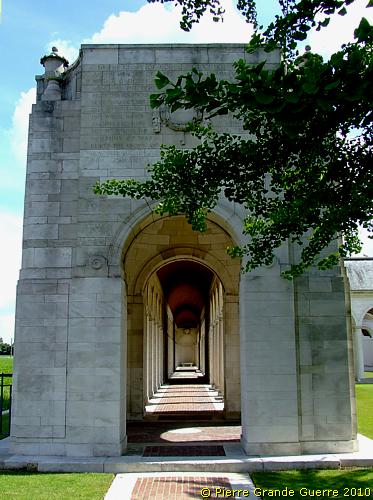
Le Touret Memorial records the names of the officers and men, who fell in the Great War in the larger area around Richebourg and whose graves are not known. It covers the period from the arrival of the II Corps in Flanders in 1914 to the eve of the Battle of Loos of 25 September 1915. It does not include the names of officers and men of Canadian or Indian regiments; they are to be found on the Memorials at Vimy Ridge and Neuve Chapelle. The names of those commemorated are listed on panels, set into the walls of the court and the gallery, arranged by Regiment, rank and alphabetically by surname. On the Memorial more than 13.000 names are listed of men, who fell in this area and who have no known grave. The memorial was designed by J.R. Truelove.
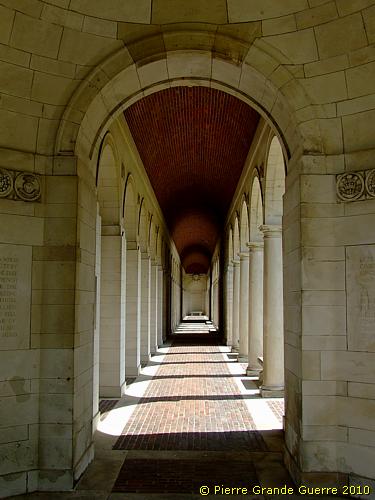
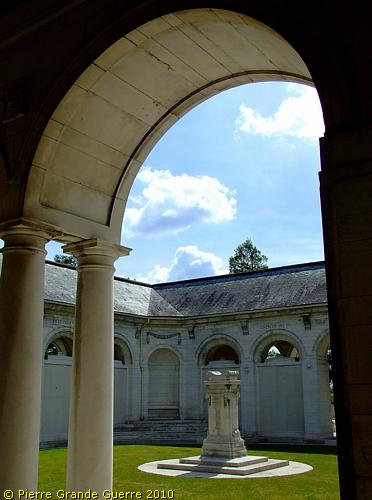
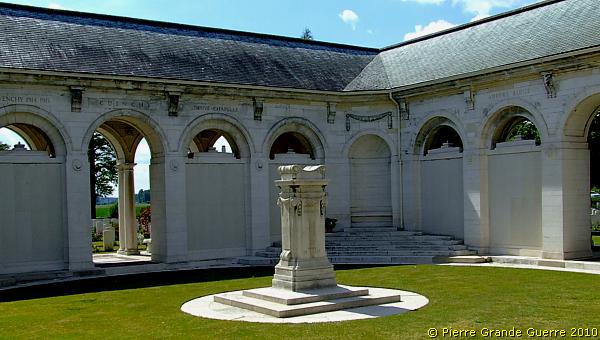
From the gallary one can always see the neighbouring le Touret Cemetery.
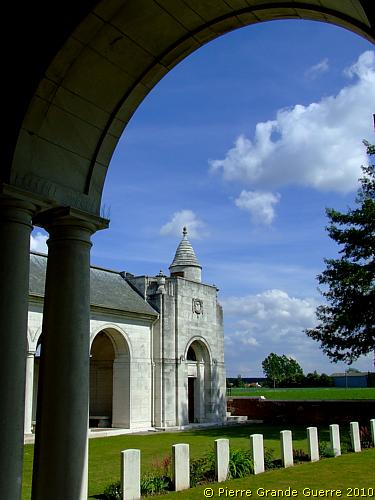
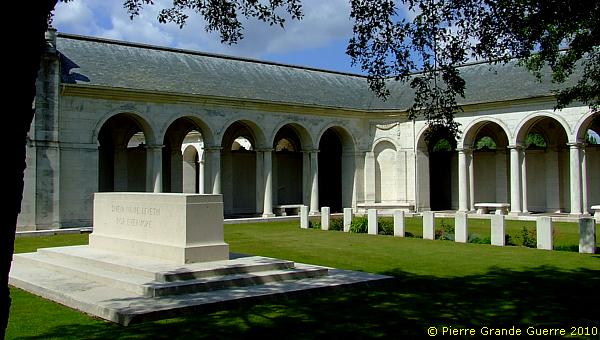

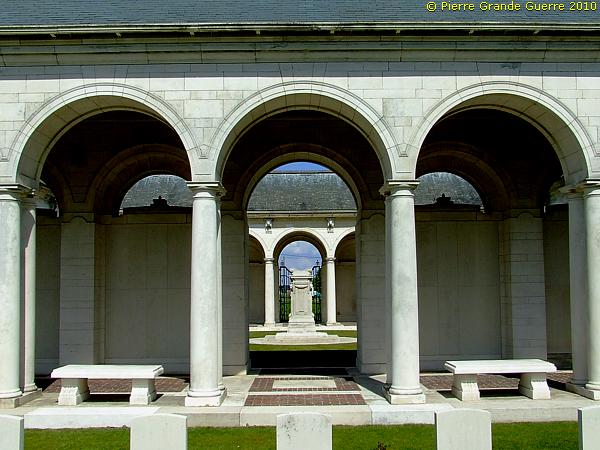

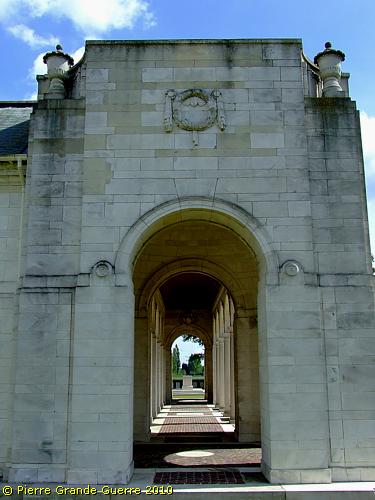
We leave the le Touret Memorial for the next stop at the village of la Couture .
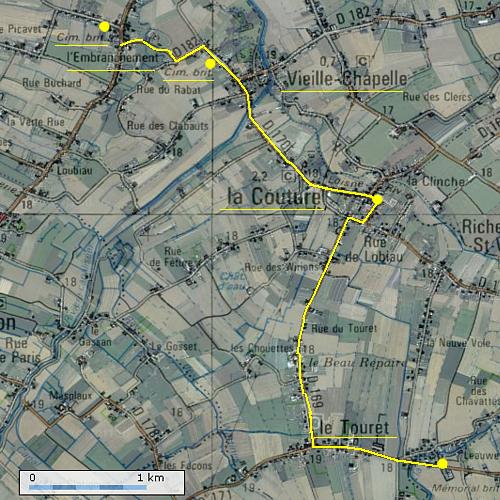
At the foot of the village church of la Couture stands this rather impressive Portuguese Memorial.
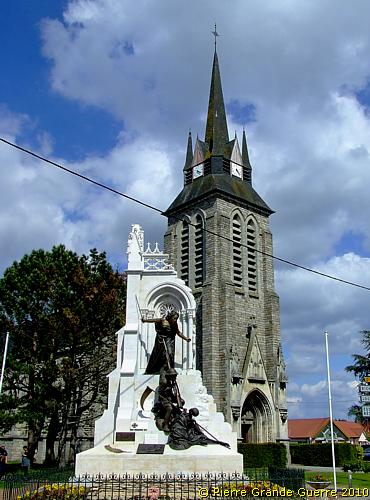
The Portuguese sculptor, Teixeira Lopes, designed this memorial with three figures: ...
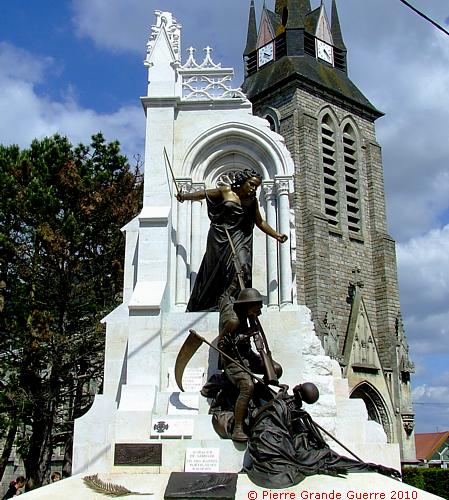
... an angry mother Portugal, ...
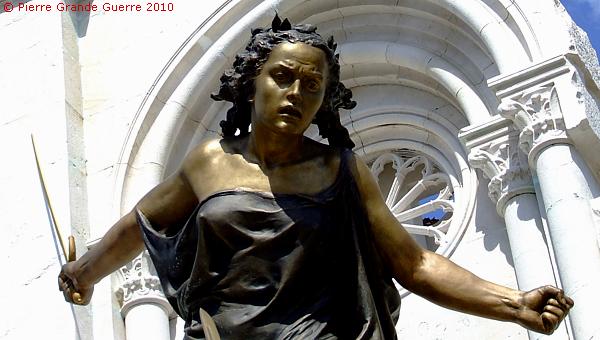
... a clearly aggressive, Portuguese soldier, ...
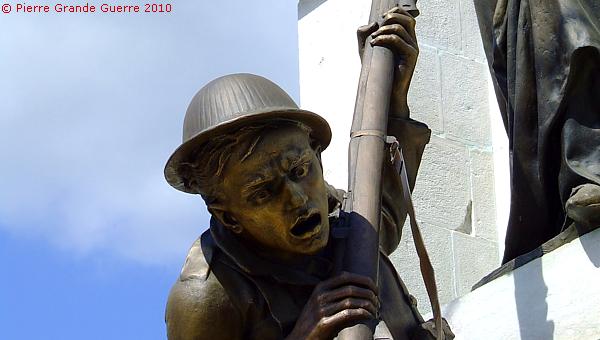
... overpowering the (German) Dead.
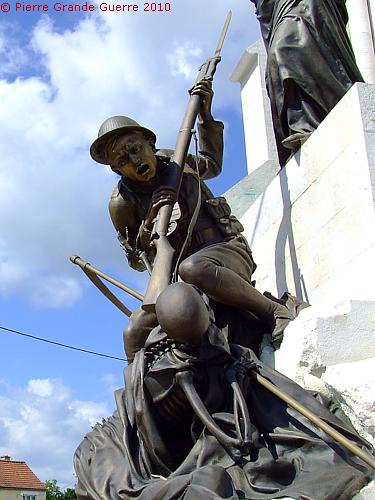
We continue north-westward to ...
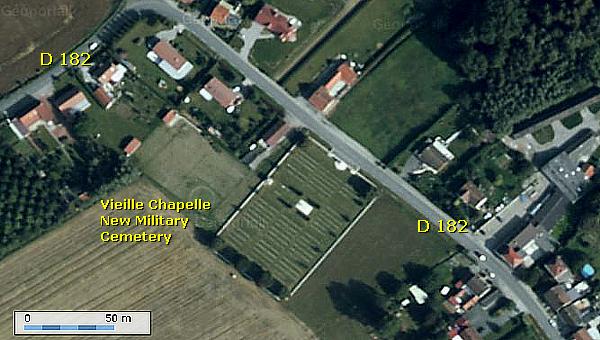
...the Vieille Chapelle New Military Cemetery .
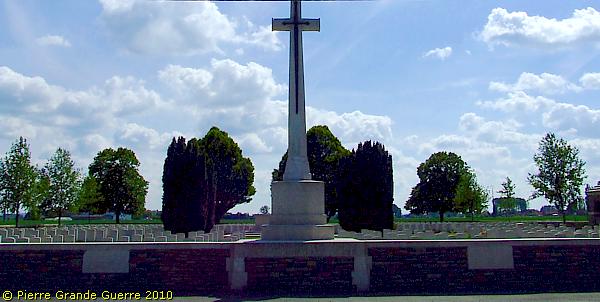
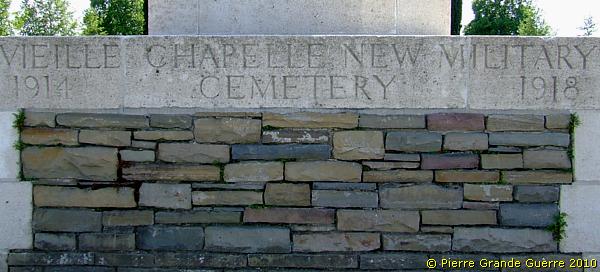
Vieille Chapelle New Military Cemetery. The Old Military Cemetery (now removed) was closed in November 1915, as being too near the village school; and the New Military Cemetery was begun in that month and used by fighting units and Field Ambulances until March 1918. The village and the cemetery fell into German hands in the following month, in the Battles of the Lys; but in September 1918, on the German retirement, some further burials took place. These original graves are in Plot I and Plot IV, Rows A and B. The remainder of the cemetery was made after the Armistice, by the concentration of British, Indian and Portuguese graves from the neighbouring battlefields and from other cemeteries; but the Portuguese graves were removed in 1925 to the Richebourg-L'Avoué Portuguese Military Cemetery. There are now nearly 1.000, 1914-18 war casualties commemorated in this site. Almost all fell in 1914, 1915, or 1918, and most of those, who fell in 1918, belonged to the 55th (West Lancashire) Division. Of these, over one-third are unidentified and special memorials are erected to five soldiers from the United Kingdom, believed to be buried among them. Other special memorials record the names of nine soldiers from the United Kingdom, buried in other cemeteries, whose graves were destroyed by shell fire. The cemetery covers an area of 4.111 square metres and is enclosed by a stone rubble wall.
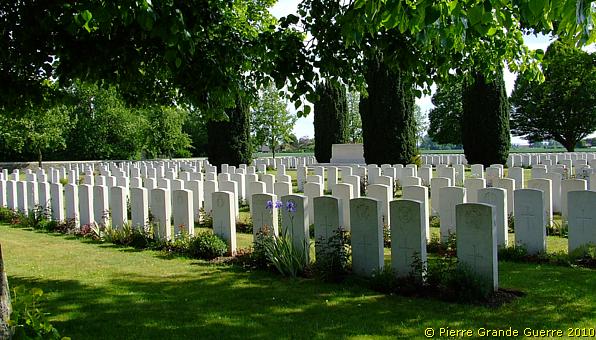
We continue westward for our visit to the last site of this trip, ...
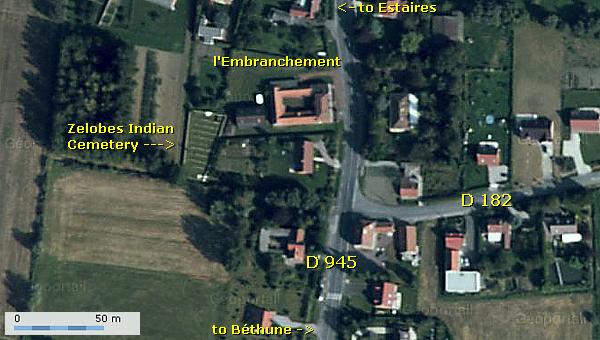
... to the Zelobes Indian Cemetery .

From the early days of the war until 11 April 1918, when it was captured by the Germans, the hamlet of Zelobes-l’Embranchement remained always in British hands. The Germans evacuated the hamlet on 30 August 1918.
Zelobes Indian Cemetery

The Zelobes Indian Cemetery was used by Field Ambulances at Zelobes from November 1914 to October 1915. There are now 105 1914-18 war casualties commemorated in this site. Of these 105, nearly a quarter are unidentified. 73 British Indian identified officers and soldiers are buried in graves. The cemetery covers an area of 611 square metres and is enclosed by a rubble wall.
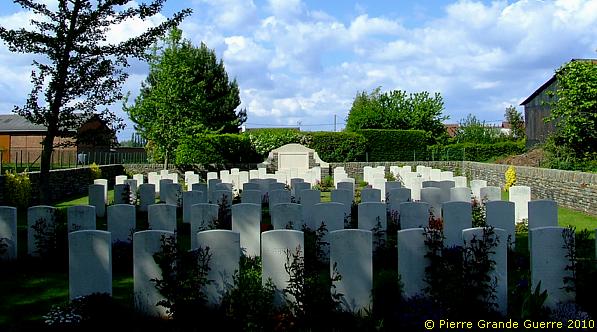
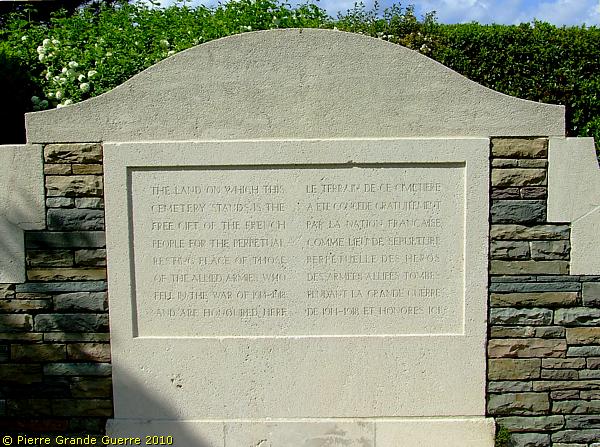
Graves of Sikh Sepoys, Privates.
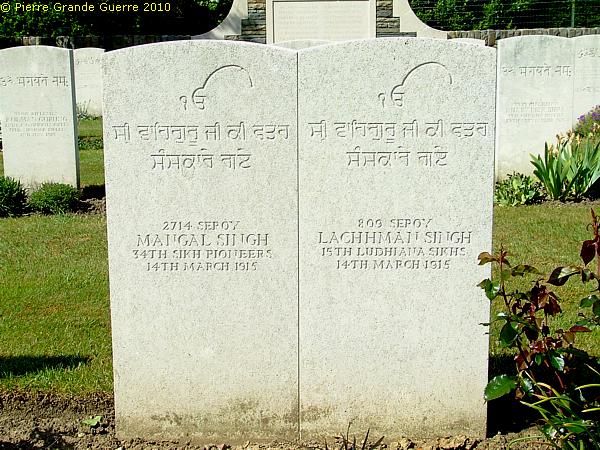
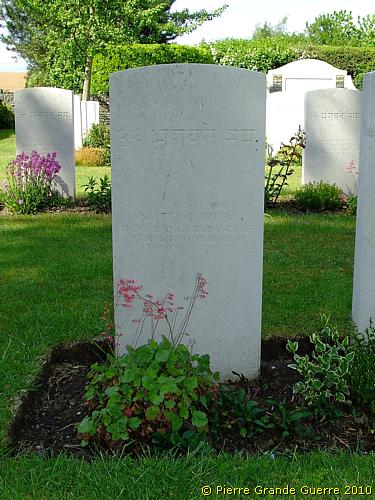
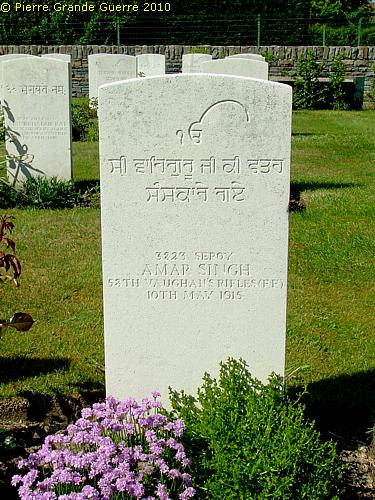
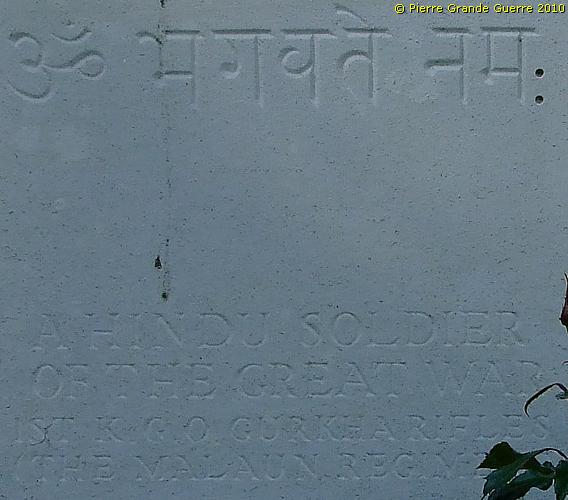
The inscription on a headstone of a Havildar, a Sergeant, of the Gurkha Rifles.

The grave of an Indian Muslim Rifleman.
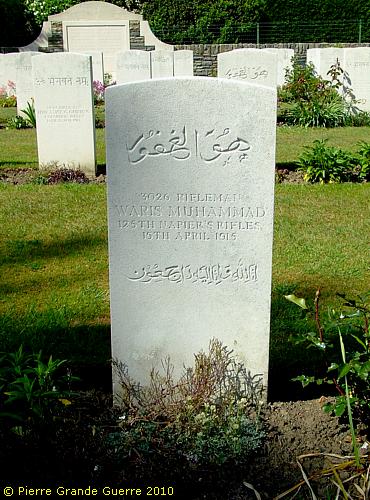
With a last view over Zelobes Indian Cemetery, we end this trip.

Continue to the next Artois chapter: " Aubers Ridge 1915 "










